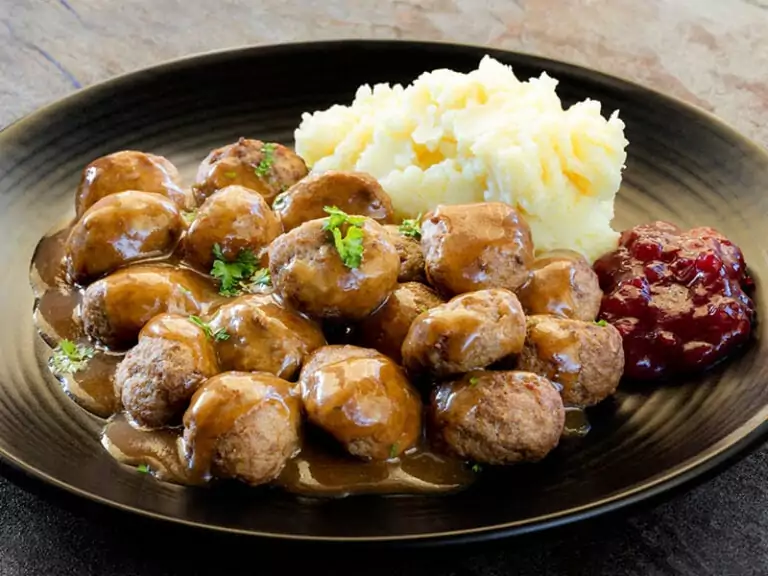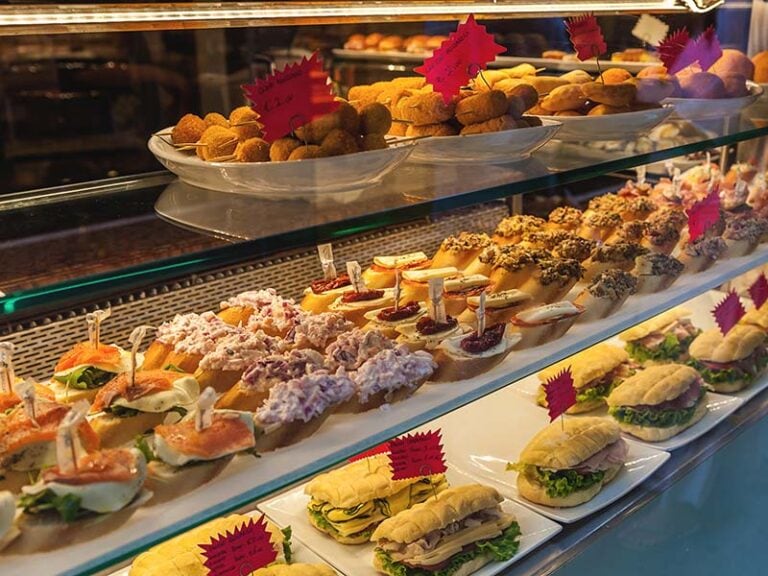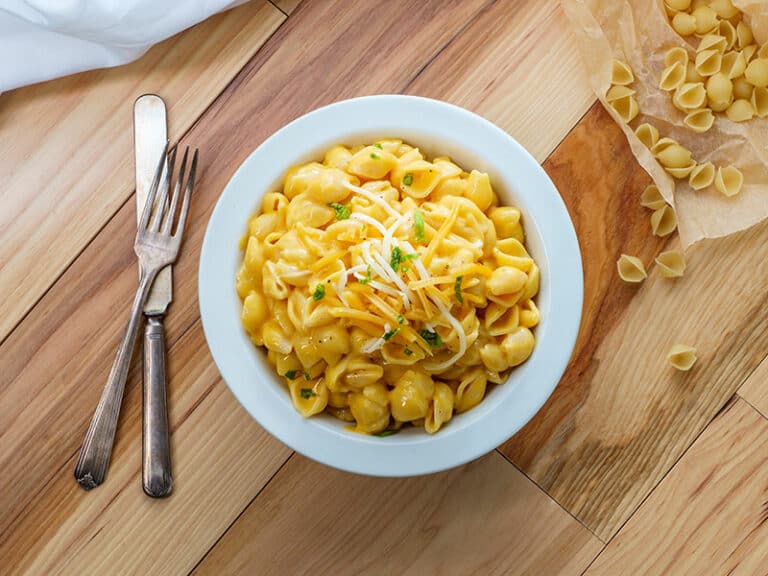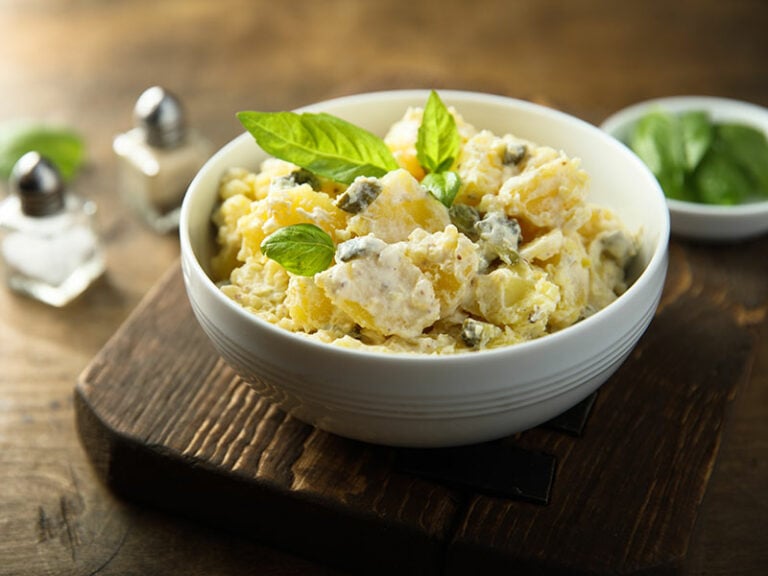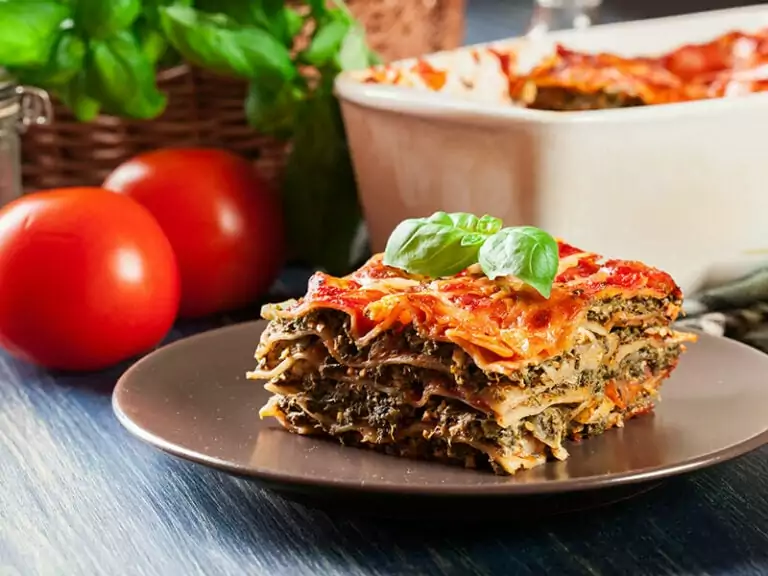Are you craving a culinary escape to the enchanting world of traditional Southern European dishes? Look no further! In this exploration, I invite you to discover the mouth-watering treasures that await.
After reading this detailed post, you’ll gain a deeper understanding of the rich cultural heritage and timeless traditions that shape these beloved dishes. Join me on this gastronomic journey and unlock the secrets of Southern European cuisine.
Overview Of Main Regional Cuisines In Southern Europe
Greece
Greece is a country known for its beautiful islands, ancient ruins, and of course, delectable food. The Greek cuisine is a perfect reflection of the Mediterranean diet, featuring olive oil, fish, lean meats, popular Greek fruits, vegetables, and grains.
Key dishes include Moussaka, a hearty layered dish of eggplant, minced meat, and béchamel sauce, and Dolmades, grape leaves stuffed with rice and herbs.
You can’t forget about Souvlaki, tender skewers of grilled meat, typically served with pita bread. And, of course, Greek Salad, a refreshing mix of feta cheese, tomatoes, cucumber, and olives.
Portugal
Portuguese cuisine boasts a rich seafood tradition, thanks to its extensive coastline. Dishes like Bacalhau à Brás, made from shredded cod, potatoes, and onions, and Caldo Verde, a kale and potato soup, showcase the simplicity and richness of Portuguese cuisine.
You’ll also find an abundance of pastries, with Pastel de Nata (custard tart) being a national favorite.
Italy
Italian cuisine varies by region, but some universal favorites include Pizza Napoletana from Naples, the creamy Risotto from Northern Italy, and the ever-popular pasta dishes such as Lasagna and Spaghetti Bolognese.
Each region has its own specialty cheeses and cured meats, like Prosciutto di Parma and Parmigiano-Reggiano cheese. And let’s not forget Gelato for dessert!
Spain
Spanish cuisine offers a wide range of dishes. It includes a variety of tapas, or small plates, such as Patatas Bravas and Gambas al Ajillo. Another classic dish is Paella, which is a rice dish often infused with saffron and cooked with a variety of seafood.
A staple of Spanish cuisine is the beloved Spanish tortilla, a thick omelet filled with potatoes. And for a sweet treat, Churros served with a side of thick chocolate sauce is a must-try.
Turkey
Turkey technically straddles both Europe and Asia. Turkish cuisine is renowned for its rich, bold flavors. Dishes such as Doner Kebab, a rotating roast of marinated meats, and Lahmacun, a thin pizza-like dish topped with minced meat, vegetables, and herbs, are common.
Turkish Delight and Baklava are well-known sweets, and a meal wouldn’t be complete without a strong cup of Turkish coffee.
Greek
1. Moussaka (Eggplant Casserole)
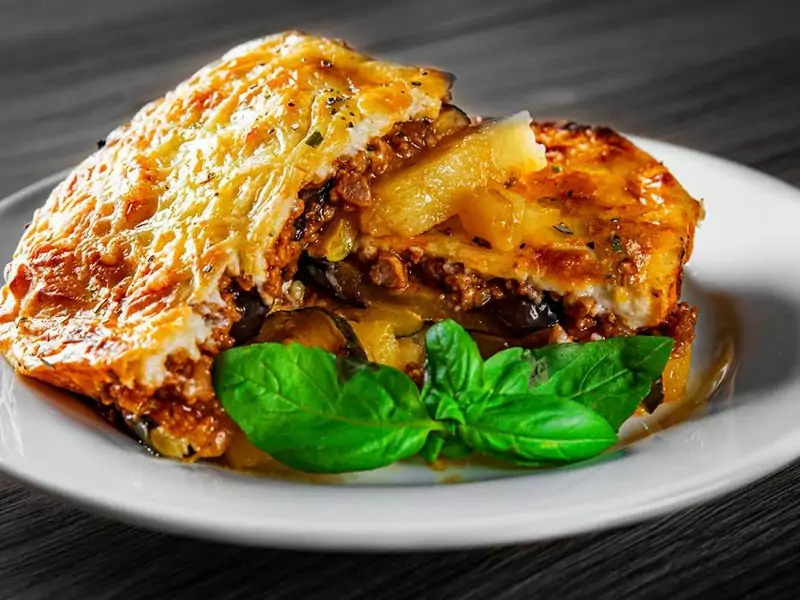
Moussaka, Greece’s national dish, is essentially a Greek spin on lasagna. This well-known food from Greece showcases layers of fried eggplant, potatoes, and seasoned ground meat—usually succulent lamb or beef—blanketed in a richly spiced tomato sauce.
This concoction then gets a lavish topping of creamy béchamel sauce before being ushered into the oven for baking. With such hearty components, moussaka doesn’t really call for an abundance of side dishes.
Walk into any taverna or restaurant from Thessaloniki to Toronto, and there’s a good chance Moussaka will be waiting on the menu. It has indeed found a home not just in Greece but across the globe.
Athens, with its cosmopolitan flair, has even seen a rise in the popularity of vegetarian versions. Now, moussaka hasn’t always been the culinary star it is today. Its humbler origins can be traced back to the Middle East, where it was once a simple dish of fried eggplants and tomato sauce.
The evolution came late in the 19th century in the palatial kitchens of the Ottoman Empire. Through chef Nikolaos Tselementes’ innovative twist, blending Greek and French culinary arts to elevate it, this once modest dish gained its spot on the global food stage.
2. Tzatziki (Cucumber Yogurt Sauce)
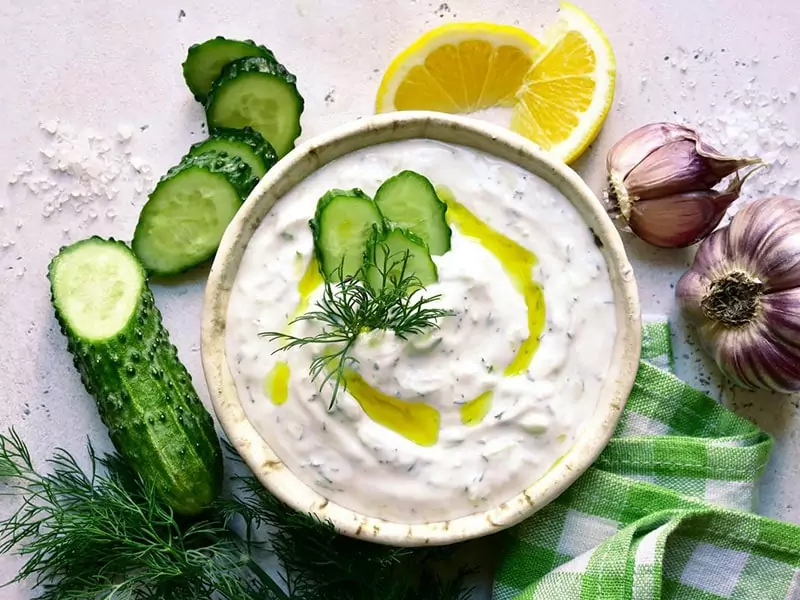
In Greece, a meal is hardly complete without Tzatziki, an intricate blend of Greek or strained yogurt, lemon juice, olive oil, cucumbers, garlic, and an assortment of herbs and spices like salt, dill, mint, or parsley.
I’ve had the privilege of enjoying it in numerous ways. It serves as a divine sauce that enhances meat dishes like gyros and souvlaki, partners as a zesty dip with pita bread or vegetables like fried eggplant and zucchini, and even transforms into a refreshing soup.
One of the many joys of sitting down to a big Greek meal is the meze, a spread of appetizers, and Tzatziki is almost always the star of this show. Its cool, creamy base, combined with the sharpness of garlic and herbs, whets the appetite perfectly.
The name ‘Tzatziki’ comes from the Turkish word ‘cacik,’ and there are theories that it might be a culinary cousin of the Indian ‘raita’ dip. Despite these foreign influences, Tzatziki holds a long tradition in Greece, predating even the Ottoman Empire.
It’s fascinating to see the adaptations of this condiment in different cuisines across the Middle East and southeastern Europe, from Iran and Iraq to Turkey, Cyprus, Bulgaria, and Serbia.
3. Gyros
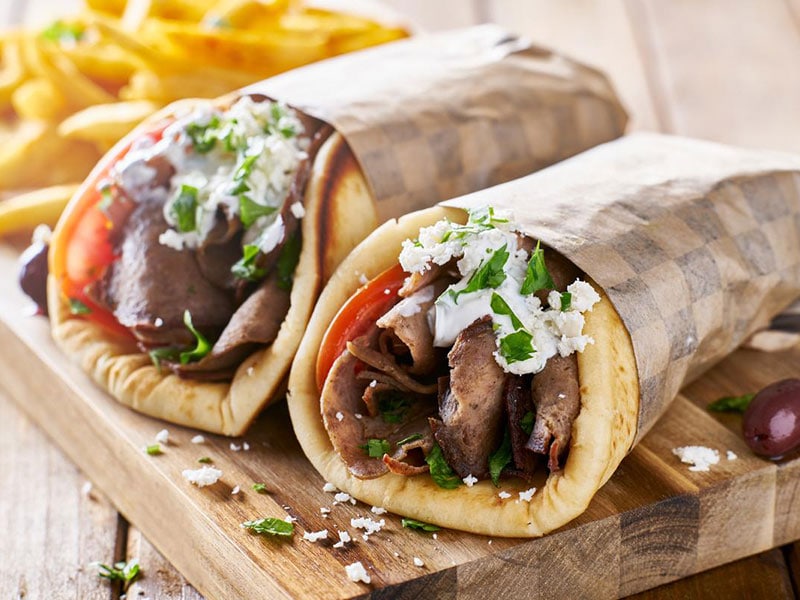
Gyros, one of the most iconic Greek street food dishes, have a special place in my heart. Whenever I’m in Athens, a gyros wrap is my go-to for a quick, satisfying lunch or dinner.
It consists of various types of meat – predominantly beef, pork, and chicken in Greece, while lamb and veal are more popular in other countries.
One can’t help but marvel at the cooking process. The meat is cooked on a vertical spit, rotating continuously, hence the name Gyros, which is derived from the Greek word ‘gheereezo’, meaning to turn.
Once cooked, it is sliced thin, as seen in similar dishes like shawarma or the Turkish doner kebab. Wrapped in a fluffy pita bread, it’s loaded with delectable fillings such as sauces like Tzatziki and a medley of fresh vegetables like tomatoes, onions, lettuce, and cucumbers.
The inclusion of French fries gives it a welcome crunch. Alternatively, I’ve also enjoyed it served over rice or salad for a bit of variety.
Believe it or not, the Gyros trace their roots back to the time of Alexander the Great. In a nod to contemporary tastes, you’ll now find vegetarian versions with grilled halloumi or feta cheese replacing the meat.
4. Souvlaki (Grilled Meat Skewers)

Souvlaki, another national treasure of Greece, has always been my go-to whenever I’m seeking comfort food. This mouth-watering dish involves skewered and grilled pork, chicken, lamb, or beef, marinated with a simple yet flavourful blend of salt, pepper, garlic, oregano, and lemon juice.
In Greece, you’ll find it served with signature Greek breads like pita alongside Tzatziki sauce, salad, tomato, rice, fries, or a simple squeeze of lemon. As a fast food item or take-out dish, souvlaki is a versatile meal, easily adapted to suit any preference.
Souvlaki first appeared in ancient Greece, with the initial version comprising grilled meat, pita bread, cheese, and dill. The name originates from the Greek word ‘souvla’, referring to a spit or skewer.
One interesting distinction is that Souvlaki consists of small pieces of skewered, grilled meat, whereas gyros are made of meat shaved from a vertical spit. And if you’re ever in Athens, do try the local version, ‘Kalamaki,’ which is usually marinated overnight.
5. Magiritsa (Greek Easter Soup)
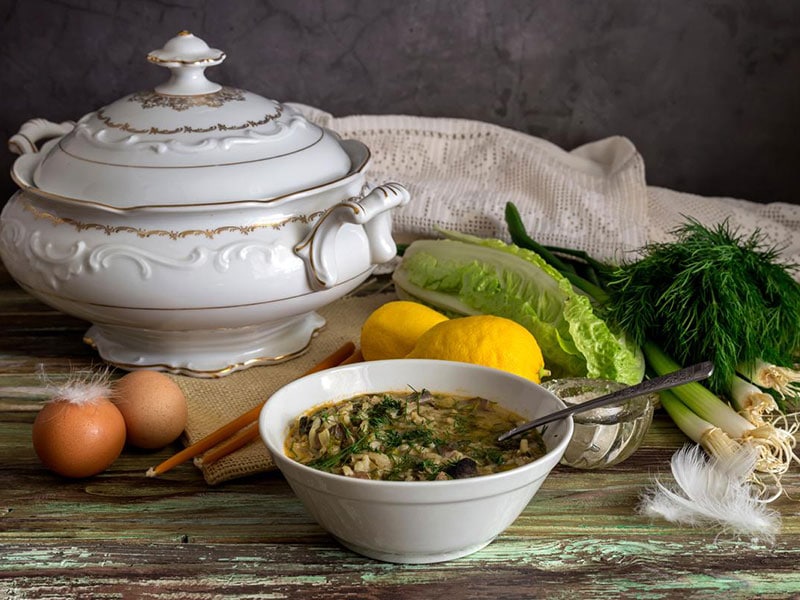
Considered a Greek national dish, Magiritsa comes in numerous varieties, although it’s primarily prepared with lamb, lamb offal, and a mix of greens, onions, and dill. My first taste of this soup dates back to a memorable Greek Easter celebration.
The roasted lamb was the centerpiece, but it was the Magiritsa that left an indelible mark on my palate. This soup cleverly uses the lamb parts unsuitable for roasting, such as the head, neck, intestines, heart, and liver.
The meat is cleaned and boiled, then cut into smaller pieces and simmered to perfection. The broth, thickened with a distinctive egg and lemon sauce and seasoned with a careful selection of spices and fresh herbs, is just exquisite.
The true beauty of Magiritsa lies in its cultural significance. Prepared on Holy Saturday, this soup is the opening meal to break the Greek Orthodox Fast or Lent and is consumed immediately after the Easter midnight church service [1].
In North America, it’s referred to as Easter soup, a fitting name that underscores its symbolic role in the Greek Easter tradition.
6. Kokoretsi (Goat / Lamb Grill)
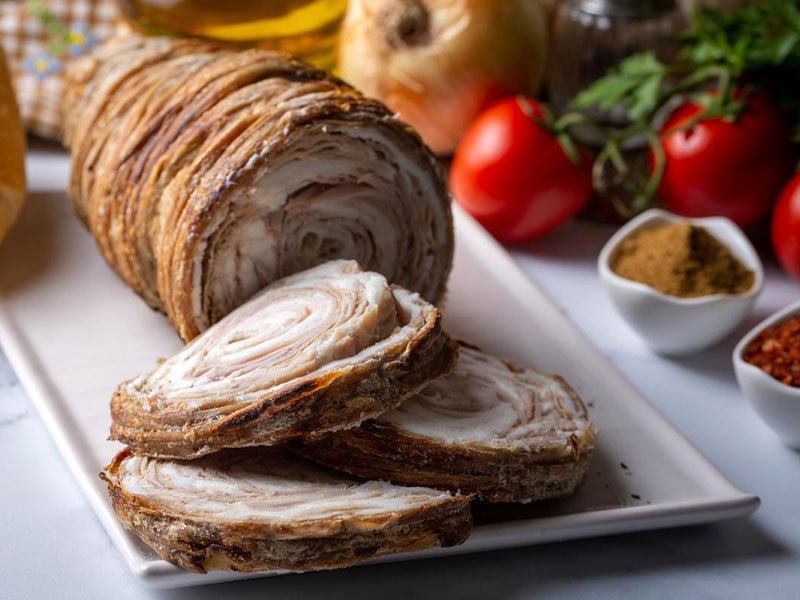
Kokoretsi is a Greek culinary tradition, primarily composed of lamb or goat offal, like hearts, livers, lungs, and kidneys. These ingredients are chopped, seasoned with lemon juice, olive oil, salt, and pepper, then skewered and wrapped in caul fat.
It’s cooked over charcoal, releasing complex flavors. Easter Sunday wouldn’t be complete without a bite of Kokoretsi served as an appetizer. But it’s not only an Easter special; you can taste it all year round at BBQ restaurants and grill houses.
This popular dish has spread throughout the Balkans and Asia Minor. Its name, interestingly, comes from the Albanian word kukurec, meaning tripe.
7. Fasolada (White Bean Soup)
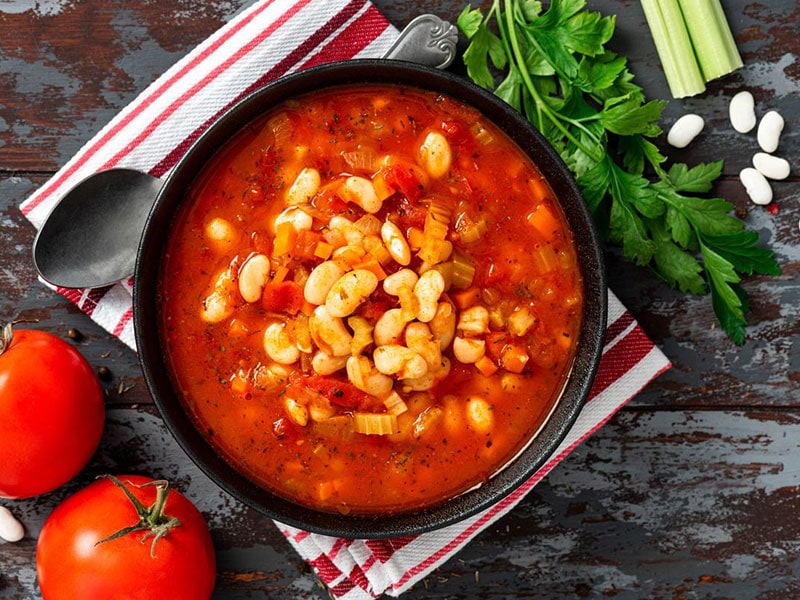
Fasolada is a comforting meatless soup deeply entrenched in Greek cuisine. A usual pick for Lent and other religious holidays, it’s a dish you’ll find in many Greek eateries.
White beans, soaked overnight, are the star of the dish. They are cooked with a mix of onions, garlic, celery, tomato passata, carrots, and herbs such as oregano, thyme, and bay leaves, adding flavor.
Extra-virgin olive oil provides a smooth finishing touch as this beloved Greek soup simmers to perfection. Accompaniments of feta cheese, olives, crusty bread, and raw onion amplify the hearty appeal of this dish.
Occasionally, you might find it served with salted and smoked herring. Besides its delicious flavor, Fasolada offers a protein and fiber-packed meal. For those who prefer a different twist, there’s Gigantes – white beans baked in a delicious tomato sauce.
8. Horiatiki / Choriatiki Salata (Greek Salad)
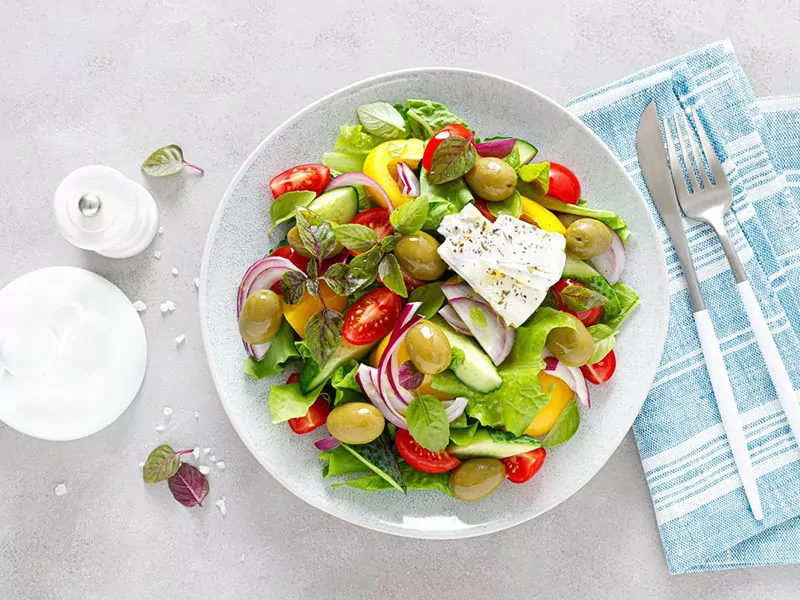
Greek Salad, or Horiatiki Salata, is the national dish of Greece, exuding simplicity, freshness, and flavors synonymous with Greek cuisine. This culinary gem has its roots in Plaka, Athens, and was created by taverna owners.
At its core, it’s a bountiful mixture of fresh vegetables: tomatoes, red onions, and cucumbers. Depending on the region, it might also come adorned with Kalamata olives, capers, green bell peppers, or even xinomyzithra, a sour ricotta-like cheese.
But it wouldn’t be a Greek salad without the generous topping of feta cheese, adding a creamy contrast to the crisp veggies. Seasonings are kept simple: just oregano, salt, and pepper.
Traditionally, there’s no lettuce in sight in this salad. Instead, the flavors are enhanced by a dressing of extra-virgin olive oil and a tangy splash of lemon juice or, occasionally, red wine vinegar.
Almost every Greek taverna has this dish on its menu. It’s a common choice for lunch and dinner, often served as a side dish. Its popularity has transcended borders, with variations found in the U.S. and beyond.
9. Saganaki (Fried Cheese)
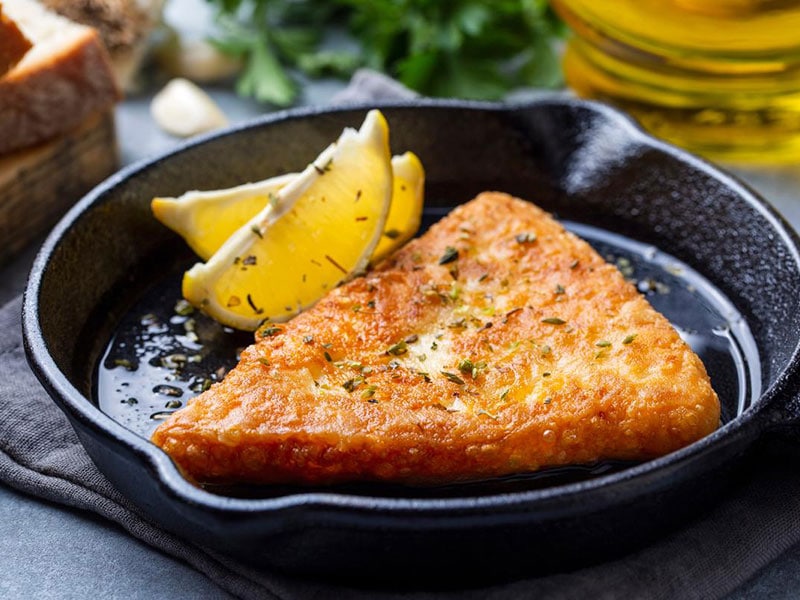
Saganaki is a famous Greek appetizer with an unmistakable golden crust, adored for its simple but captivating flavors. To whip up this delicacy, one uses a selection from a spectrum of cheeses, such as feta, kashkaval, graviera, kefalograviera, kasseri, kefalotyri, or manori.
The cheese may stand alone or be entwined with vegetables, meats, or seafood, from shrimp to mussels. Seared or pan-fried, the result is a visually appealing and satisfying dish. It also tastes phenomenal with some bread, a sprinkle of pepper, and a squeeze of lemon juice.
The dish’s name, Saganaki, hails from the sagani, the small, two-handled pan traditionally used to prepare and present it. There are fascinating regional spins on Saganaki too, with formaela cheese starring in Arachova and halloumi taking center stage in Cyprus.
Some Greek restaurants even offer a Flaming Saganaki, where the cook douses the cheese in liquor and sets it ablaze, adding a theatrical element to your meal.
10. Tirokroketes (Fried Cheese Balls)
Tirokroketes, the appetizer that’s made its home in nearly every Greek tavern, has roots that reach back to ancient Greece. Bringing together the distinct flavors of feta, graviera, and gouda, this dish combines three kinds of cheese in a harmonious blend.
Each cheese ball, enveloped in bread crumbs, undergoes a deep-fry transformation, resulting in a crisp, irresistible exterior that encases a melt-in-your-mouth cheesy core.
Accompanied by a dip into a bowl of tangy Tzatziki or vibrant tomato sauce, each bite becomes an exploration of flavor. Served as an appetizer, Tirokroketes is the ideal introduction to a Greek meal, offering a tantalizing taste of what’s to come.
11. Spanakopita (Spinach Pie)

Spanakopita is a beloved Greek dish, hailing from the times of the Turkish occupation of Greece, some 400 years ago. This dish, a type of borek pastry, shares similarities with a Turkish dish called Ispanaki, emphasizing the interconnectedness of food and history.
The star of Spanakopita is a buttery, flaky phyllo pastry, lovingly brushed with butter or olive oil, which houses a vibrant filling. This filling brings together spinach, lemon juice, feta cheese, onions, and eggs, sometimes with a hint of dill.
Variations on the theme are also aplenty, with enriched dough or different fillings, such as salted cheese like kefalotiri, aubergines, meat, or other greens.
From Greek diners and taverns to upscale restaurants, Spanakopita is a versatile dish, fit for any time of the day, be it breakfast, dinner, or anything in between. As a snack, appetizer, or light main course, it plays different roles in a meal, showcasing its flexibility.
On Greek Easter, it becomes a popular dish, bringing a taste of tradition to the table. Often, it is paired with Tzatziki sauce, garlic, and cucumbers, adding a refreshing touch to this savory pie.
12. Fava (Yellow Split Peas Puree)
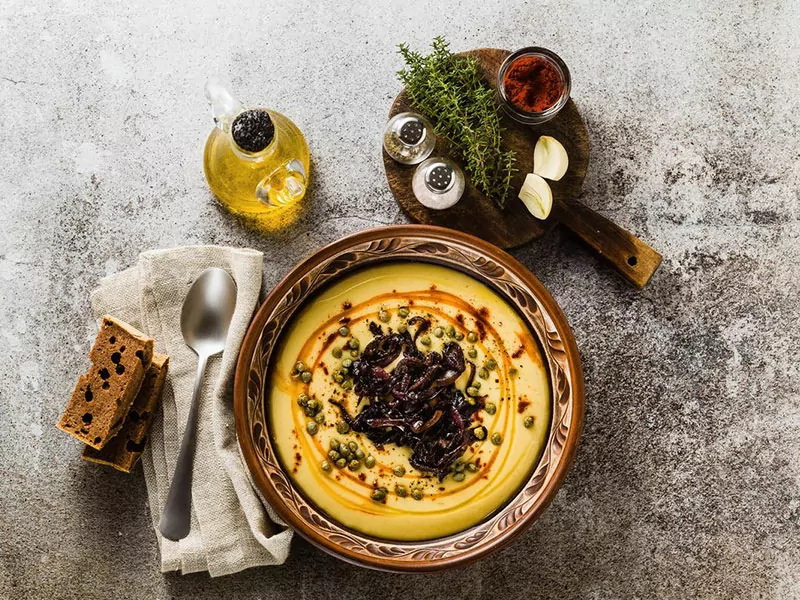
Fava is a creamy and velvety purée that might just catch your eye. With a similar texture to hummus, it’s the Greek twist on the classic spread, combining yellow split peas, olive oil, herbs, garlic, onions, and spices into a mouthwatering concoction.
Its name, derived from the Latin word ‘favus,’ speaks of broad or fava beans. This dish holds a special place on the island of Santorini. For 3500 years, Santorini fava has been cultivated, giving rise to the famed “Fava Santorinis.”
Such is the significance of this dish that it secured a protected designation of origin (PDO) from the European Union in 2010, standing as an emblem of Santorini cuisine.
Presented as a meze dish or appetizer, Fava glistens under a drizzle of extra-virgin olive oil, with diced onions and parsley adding a pop of freshness. Sidekicks such as feta cheese, capers, olives, tomatoes, and cucumber create a symphony of flavors.
Paired with pita, flatbread, or crusty bread, Fava takes center stage, turning each bite into a delicious journey through Greek culinary traditions.
13. Taramasalata (Fish Roe Dip)
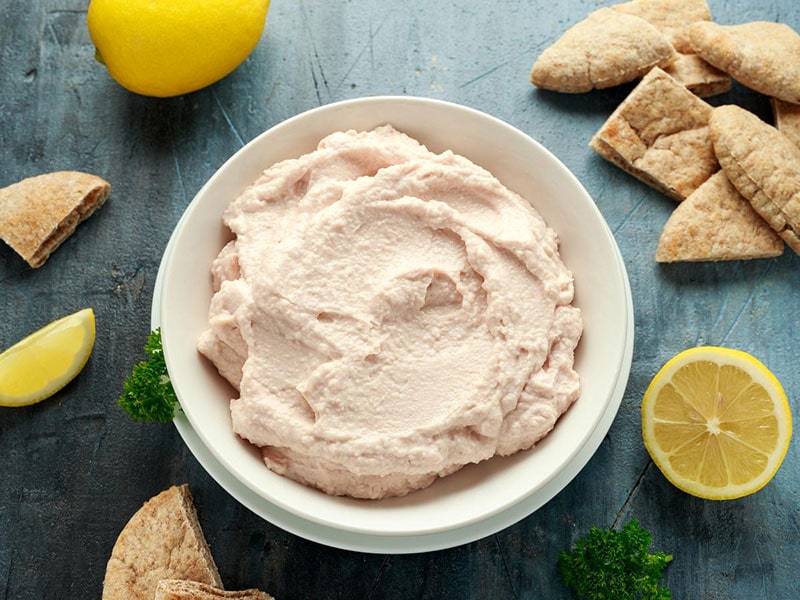
Taramasalata is an appetizing dip made from mashed potatoes or bread, and occasionally breadcrumbs. This flavorful concoction owes its unique taste to a blend of lemon juice, olive oil, and fish roe from either cod, carp, or gray mullet, with some variations adding a dash of milk for an extra creamy texture.
The authentic preparation of Taramasalata involves the traditional use of a mortar and pestle, grounding the ingredients to a fine consistency. Garnishing follows, with olives, tomatoes, and cucumbers adorning the dish, further enhancing its appeal.
Taramasalata, served as an appetizer or a meze dish, is a perfect spread with bread. The tradition associates it with Clean Monday, marking the first day of Lent, a significant occasion in Greek culture.
Yet, a word of caution – pre-made versions, with their unusual pink hue from excessive food coloring, have somewhat tarnished the authentic Taramasalata’s reputation.
14. Giouvetsi (Beef Stew With Orzo)
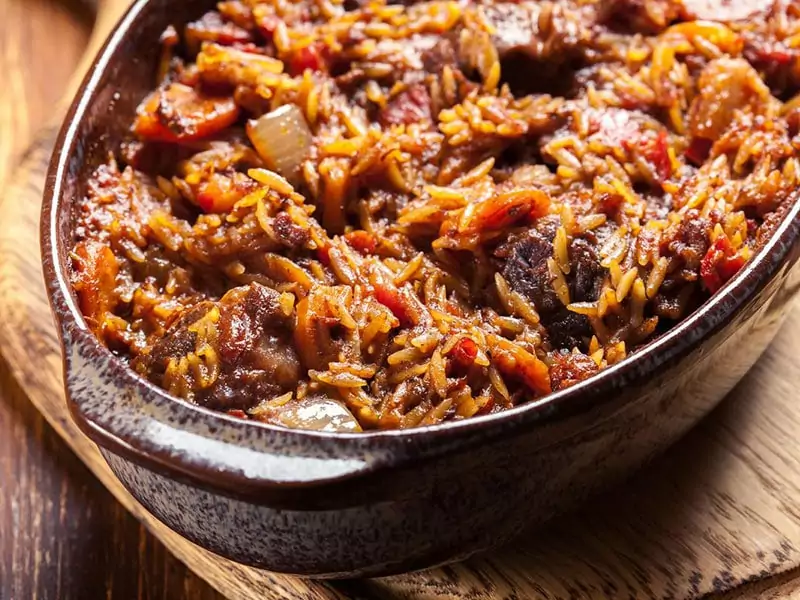
If there’s a dish that embodies the warmth and heartiness of Greek cuisine, it’s Giouvetsi. This casserole combines pasta and tomato-braised meat, bathed in a tomato sauce infused with aromatic Mediterranean spices: cinnamon, allspice, red wine, cloves, and bay leaves.
The flavors meld perfectly under the broiler, and a sprinkle of grated cheese finishes off the dish. Veal or lamb are traditional choices for the meat, but options like beef, chicken, and even seafood add their twist.
As for the pasta, two forms hold sway: kritharaki, akin to orzo, and square-shaped hilopites. And while this mouthwatering meal is now often oven-baked, its roots are in a clay pot, inspired by the Turkish earthenware its name recalls.
15. Pastitsio (Greek Lasagna)
Pastitsio, often considered the Greek version of lasagna, has earned a spot in the hearts of food enthusiasts globally. This dish is well known for its delectable layers that are meticulously assembled.
Starting with pasta, followed by ground beef or lamb, each layer adds its unique character to the dish. This is further enhanced by the tomato sauce and a creamy layer of béchamel sauce. To top it all, a generous layer of melted cheese crowns the dish.
But don’t get it twisted; it’s not an Italian wannabe. This is an authentic Greek classic, its character underscored by the use of tubular pasta like bucatini instead of flat pasta sheets, as in Italian lasagna.
Furthermore, its signature flavor comes from a fragrant mix of nutmeg, cloves, allspice, and cinnamon, spices that bring a unique Greek spin to the dish.
Whether you are in Greece or at a Greek restaurant abroad, Pastitsio is a crowd-pleaser. A serving of it, usually accompanied by a mixed green salad, can transport you straight to a sunny taverna by the Aegean.
16. Stifado (Red Wine Beef Stew)
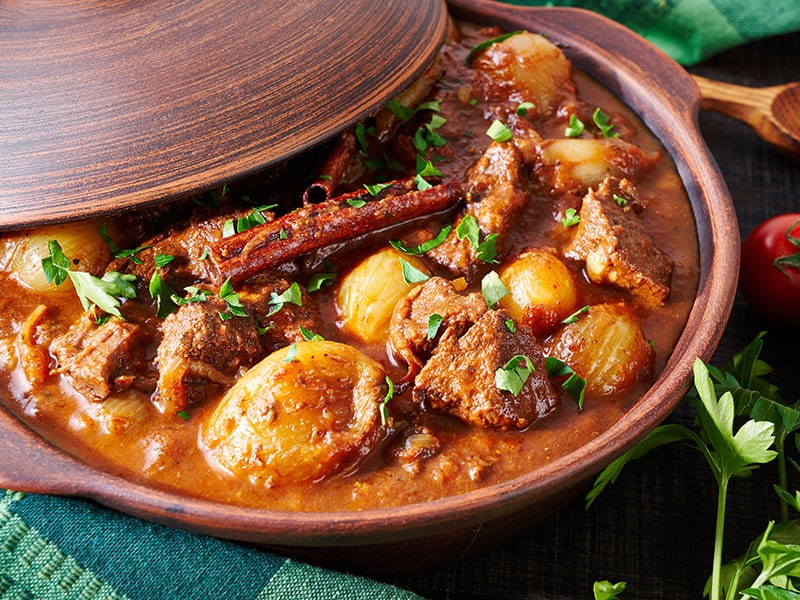
Stifado is a slow-cooked stew with an Italian name, Stufato, meaning stewed, reflecting its rich culinary history.
This delicacy made its way to Greece around the 13th century, courtesy of the Venetians. Over time, it gradually incorporated Levantine influences, which is evident in the delicious choice of spices like cinnamon, cloves, and allspice.
The essential ingredients of Stifado are beef and pearl onions stewed in a tomato-based sauce until the meat turns tender. Cinnamon, tomatoes, and a splash of cognac wine or red wine vinegar are added to enhance the flavor.
Stifado isn’t strictly a beef stew; it can be made with various types of meat like goat, rabbit, wild hare, snails, tripe, or even octopus. Plant-based versions are equally appetizing, featuring mushrooms and chestnuts.
Stifado is traditionally paired with rice, Greek pasta, or mashed potatoes, offering warmth and comfort on cold winter days.
17. Galaktoboureko (Custard Pie)

Galaktoboureko, intriguingly named “milk borek,” is a sweet Greek pie creation that is hard to resist. It captures your taste buds with its custardy texture, akin to a flan, housed within layers of delicate phyllo pastry.
This dish takes on a unique character as semolina custard is nestled within the pastry, embellished with droplets of melted butter and a whisper of cinnamon. Once it’s baked to perfection, the pie is allowed to chill thoroughly.
As the final step, a sweet, clear syrup cascades over the well-chilled pie, imparting flavors of lemon, orange, or rose. This creates a beautiful contrast between the crunchy pastry and the soft, creamy custard.
So, if you’re wandering through Greece and come across a traditional tavern or a local pastry shop, this is one dessert you wouldn’t want to miss.
18. Loukoumades (Greek Donuts / Doughnuts)

Loukoumades, essentially the Greek version of doughnuts, are little orbs of happiness that are a hit with both children and adults alike. Made from typical dough ingredients like flour, yeast, and either water or milk, these are then transformed into golden globes of goodness via deep-frying.
For an extra touch, they’re sometimes adorned with a sprinkle of tasty dried fruits, sesame seeds, walnuts, or even cinnamon.They can be relished plain or taken up a notch when accompanied by ice cream or drizzled with honey syrup.
As a dessert, they’re omnipresent throughout Greece, but you’ll find them particularly loved in Athens. Known to be one of the oldest pastries in the world, Loukoumades has a storied history.
They were traditionally made to honor saints during feasts, and early Christians even prepared them on New Year’s Day to pay tribute to Virgin Mary.
19. Tiropita (Greek Cheese Pie)

Tiropita, a beloved Greek snack or dessert, wraps a tangy filling of cheese, typically feta, and eggs within layers of flaky phyllo dough. These parcels of tastiness are lavishly brushed with olive oil or melted butter, ensuring a beautifully golden and crisp crust upon baking.
As ubiquitous as the Mediterranean sun, you can spot them in virtually every Greek bakery. While Tiropita makes for a sumptuous appetizer when drizzled with honey or served with a variety of dips, it doesn’t stop there.
Many Greek folks start their day with this cheesy dish, making it a favored breakfast item. It’s also popular as a midday snack.
20. Greek Yogurt

Greek yogurt stands out from its counterparts thanks to a unique straining process that results in a denser, creamier product.
Cultured and fermented milk is strained through fine mesh or cloth bags, bidding farewell to whey and leaving only the thick, luscious solids behind. After this process, you’ll have yogurt that’s soft, smooth and exudes a brilliant white hue.
A spoonful of Greek yogurt brings you a clean, slightly tart flavor, making it a versatile star in the kitchen, from breakfast bowls to savory dips and delectable desserts.
21. Kefalograviera Cheese
Taking its name from two cheese legends, Kefalograviera blends the intensity of Kefalotyri with the mellowness of Graviera, striking a balance that pleases the palate.
This hard table cheese, hailing from Western Macedonia, Epirus, Aitoloakarnania, Evrytania, and western mainland Greece, has been a part of the dinner table since the 1960s.
Made from sheep’s milk or a mix of sheep’s and goat’s milk, it boasts a firm texture and a light brown rind. Kefalograviera has quickly carved a niche for itself in the Greek culinary scene, notably starring in Saganaki preparations.
22. Portokalopita (Orange Cake)
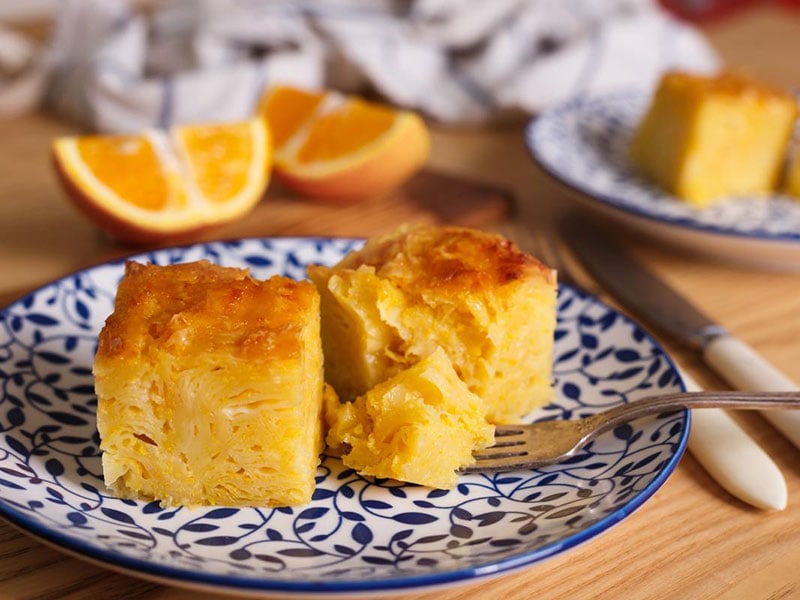
Portokalopita, a quintessential Greek Orange Cake, is a fusion of shredded phyllo sheets blended with a luscious, orange-flavored yogurt custard. Fresh out of the oven, this treat is doused in a thick, sugary, orange-spiked syrup, infusing each bite with a citrusy sweetness.
Elevating its taste are elements of semolina, cinnamon, vanilla, and a touch of dried or candied fruit. It’s not uncommon to see variations of Portokalopita across Greece. Whether relished solo or complemented with ice cream, this well-chilled cake becomes an irresistible indulgence.
23. Spanakorizo (Spinach And Rice)
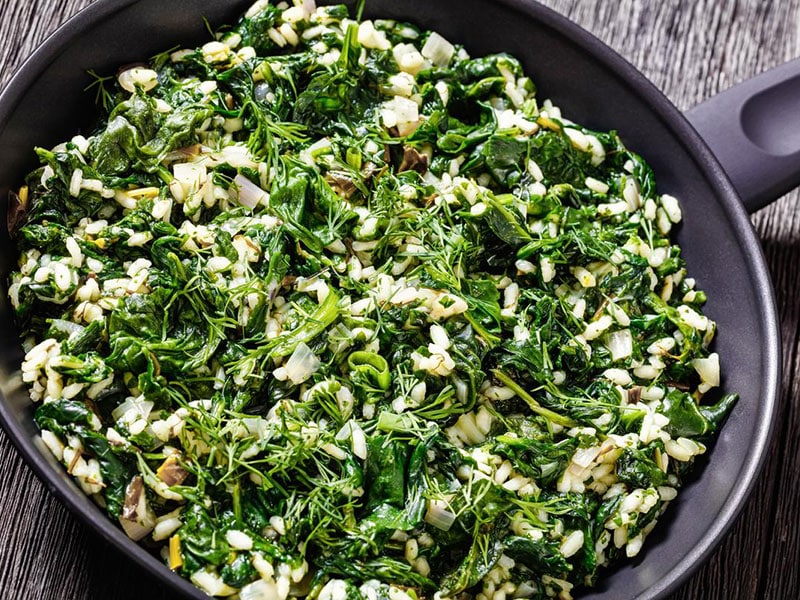
Spanakorizo is a simple, wholesome Greek dish. The name combines “spanaki” for spinach and “rizi” for rice, and it’s as straightforward as that. The dish is slowly simmered rice and spinach, seasoned with a touch of lemon juice and olive oil.
A few additional ingredients are thrown in for good measure – spring onions, chickpeas, leeks, and a careful selection of herbs and spices. This dish has roots in Lent traditions, but it’s now a year-round favorite.
It’s either a healthy main course paired with feta or a subtle accompaniment to meat or seafood dishes.
24. Melomakarona (Christmas Honey Cookies)
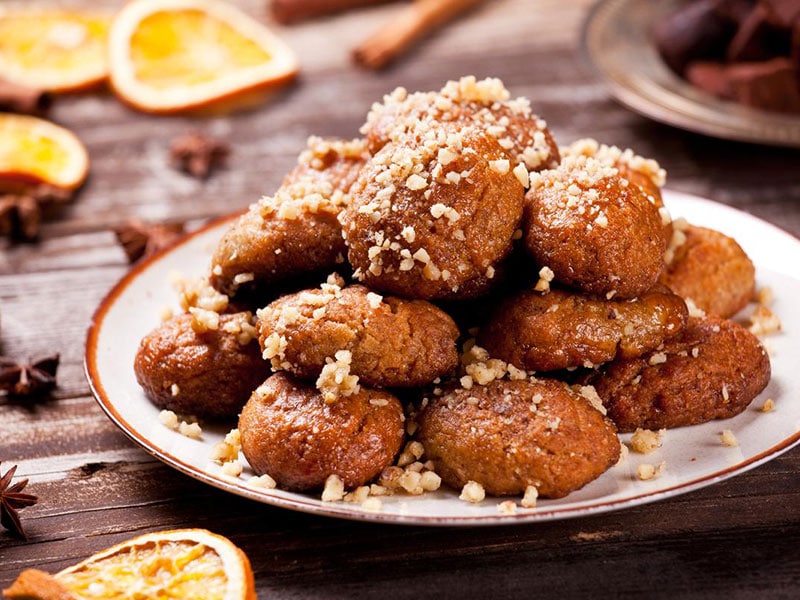
Melomakarona, also known as Finikia, are iconic Greek Christmas food and sweet treats. These semolina cookies captivate with traditional flavors of honey, orange zest, cinnamon, and olive oil, occasionally enlivened by cognac.
After baking, they’re doused in honey syrup, soaking up the sweet liquid, then sprinkled with ground walnuts for extra crunchiness.
25. Tsoureki (Easter Bread)
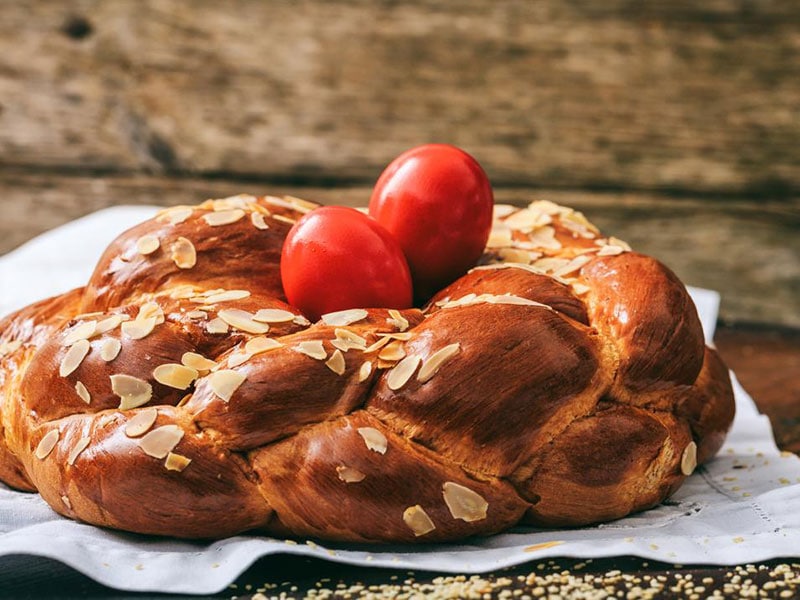
When it’s time for Easter in Greece, you’ll see Tsoureki on every table. This Greek Easter bread is distinctive, with its signature braided shape, each of the three strands symbolizing an aspect of the Holy Trinity.
The bread can be circular or elongated like a loaf, showcasing its beautiful braid. As for the flavor, it’s a delicious blend of milk, eggs, butter, and aromatic ingredients such as mahleb, orange zest, cardamom, and vanilla.
In addition to the exquisite taste, Tsoureki carries deep symbolism. It’s traditionally topped with a red-dyed egg, a powerful symbol of Christ’s blood and resurrection.
This bread isn’t only served at the breaking of Lent; it’s also shared among friends and family on Easter Sunday as a symbol of goodwill and friendship.
Portuguese
26. Caldo Verde (Green Soup)
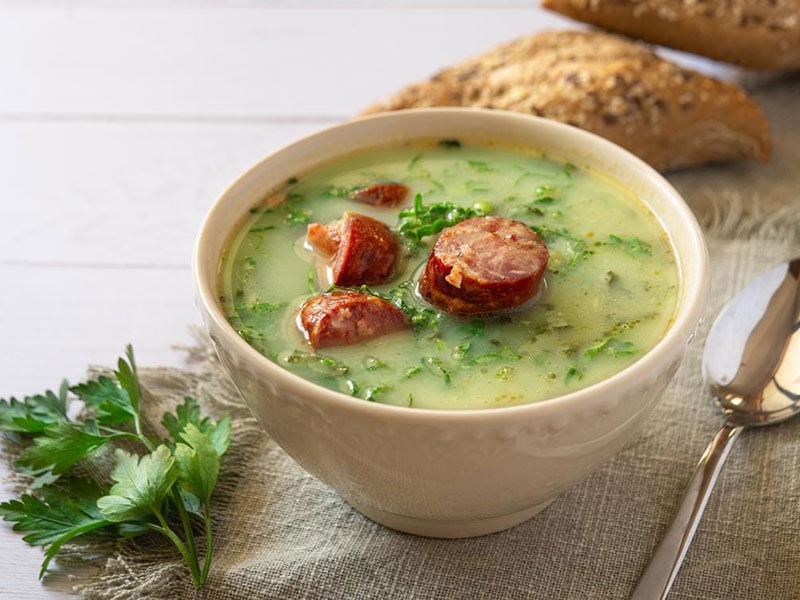
Caldo Verde, translated as “Green Soup,” is a warming culinary emblem of Portugal, hailing from the Minho Province in the north.
At its heart are simple, wholesome ingredients: kale finely shredded into a vibrant green, onions, potatoes, garlic, olive oil, and a kick of chouriço or linguica. Some might substitute kale with collard greens or even opt for a vegetarian version.
This soup is virtually omnipresent across Portugal. Savoring it with broa, a hearty Portuguese corn and rye bread, elevates the experience. Whether for brunch or a snack, Caldo Verde wraps you in a comforting, gastronomic embrace.
27. Alheira Sausage
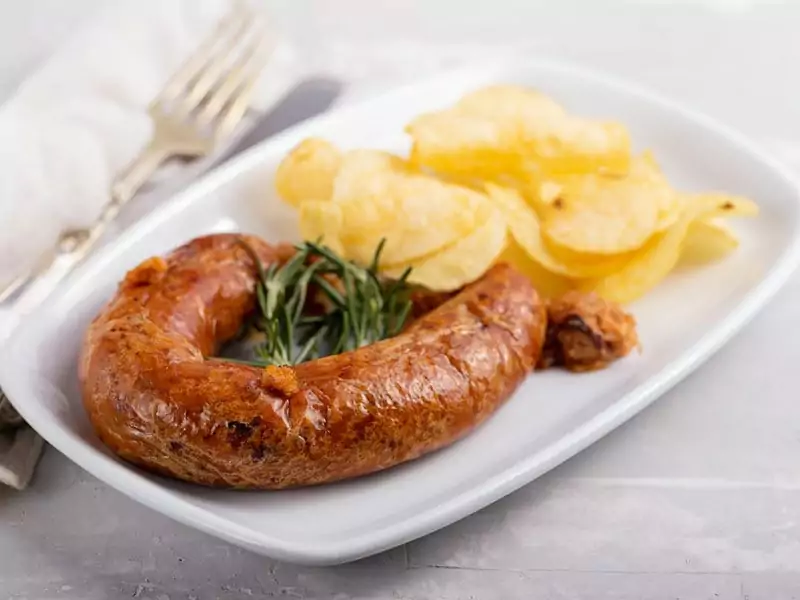
Alheira sausage provides a flavorful smoked sausage with intriguing roots tracing back to the Inquisition period. To appear as converts to Christianity, Jewish people ingeniously created Alheira, replacing the pork with other meats like chicken, rabbit, duck, or quail, and adding bread to the mix.
The name, deriving from ‘alho’ meaning garlic, suggests the zesty punch it delivers. I’ve savored Alheira as a starter, but it also commands center stage as a main course. Whether roasted, grilled, or lightly fried, the flavors of Alheira burst on the tongue.
When served alongside rice, salad, boiled vegetables, and fries, the diversity in textures complements the sausage beautifully. And, of course, topping it with a fried egg just rounds off the whole dish.
28. Queijo Serra da Estrela / Queijo da Serra Cheese
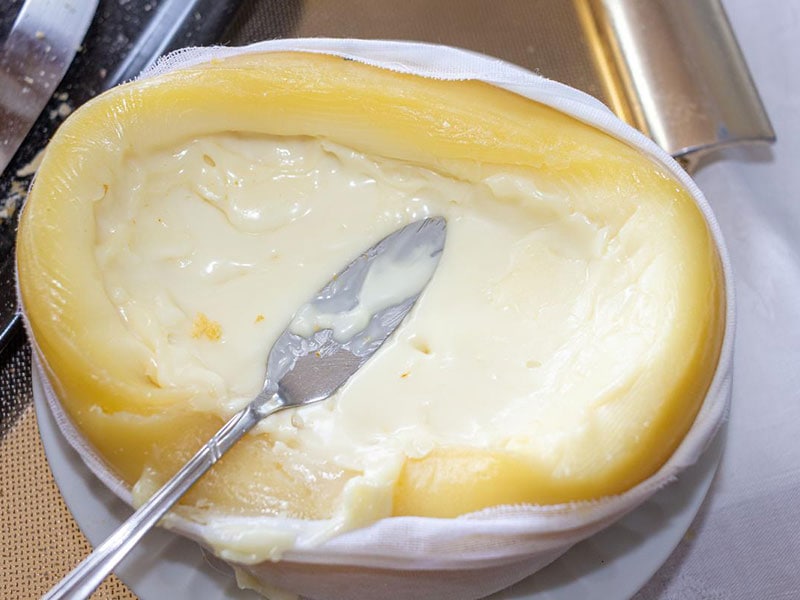
Queijo Serra da Estrela, or Queijo da Serra Cheese, is a cherished sheep cheese from Portugal. This specialty is derived from sheep grazed in Serra de Estrela, the highest mountain range in north-central Portugal.
When ripe, it’s so soft that you can scoop it out with a spoon, lending a unique charm. Its flavor profile is intriguing – slightly sour yet utterly delicious. Freshly served with a hint of salt and pepper, or topped with honey, nuts, or preserves, it easily steals the spotlight as an appetizer.
Pairing it with salted cod or featuring it on Petiscos, the Portuguese version of tapas, can also be a fantastic idea. This cheese earned its designation of origin label (PDO) and was included in the Ark of Taste in 2014 [2].
29. Arroz de Marisco (Seafood Rice)
Arroz de Marisco, or Seafood Rice, traces its roots to a seaside cafe in Praia de Vieira de Leiria. This Portuguese gem blends seafood, tomatoes, peppers, and rice. Choices of seafood are many, with prawns, mussels, and clams being favorites.
Some might opt for a touch of luxury with lobster or crab meat or a unique flavor twist with tamboril (monkfish), bacalhau, squid, or other shellfish. A sprinkle of herbs and a dash of white wine lend additional aromatic notes.
While it might remind you of Spanish paella, Arroz de Marisco stands out with its unique sauciness. Think of it as a soupier Portuguese take on risotto, radiating seaside charm and flavors in every bite.
30. Leitão (Suckling Pig)
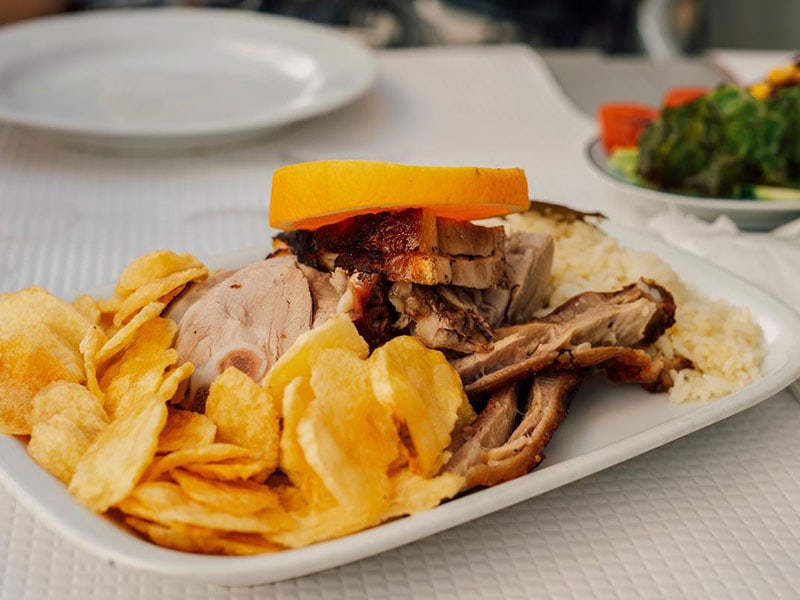
Leitão, or suckling pig, is a beloved dish around Coimbra. A blend of garlic, grease, salt, and pepper enhances the natural flavors of the pig, which gets roasted with aromatic eucalyptus wood.
This special process results in a golden-orange, crisp skin that’s impossible to resist. But the meal doesn’t stop there. The tender, flavorful pig is paired with batatas fritas – that’s fries for you – and a refreshing salada mista composed of lettuce, tomato, and onion.
This combination of succulent meat and crisp sides ensures that each bite is a balance of textures and flavors.
31. Sardinha Assada (Grilled Sardines)
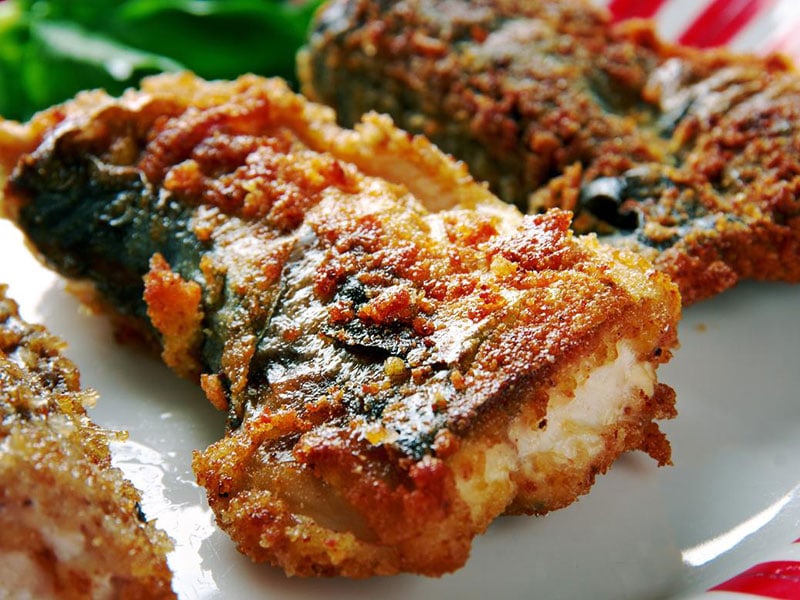
Sardinha Assada, or Grilled Sardines, reigns as the national icon of Portugal. These little fish, glistening from a marinade of Portuguese olive oil and coated with salt, are then placed on a charcoal grill. The resulting smoky flavor is unparalleled.
Once grilled to perfection, they’re best savored hot, right off the grill. Accouterments like pepper, tomato, onion, salads, rice, or boiled potatoes enhance the flavor.
In Portugal, summer, especially from June to August, is the peak season for these grilled delights. This period coincides with the annual Sardine Festival in Lisbon and the Feast of Saint Anthony, which is celebrated on the 12th and 13th of June.
During this vibrant festivity, the standout is the humble sardine on bread. It’s a testament to the Portuguese love for sardines, with 12 pounds consumed per person annually [3]!
32. Pastel de Belém / Pastel de Nata (Custard Tarts)
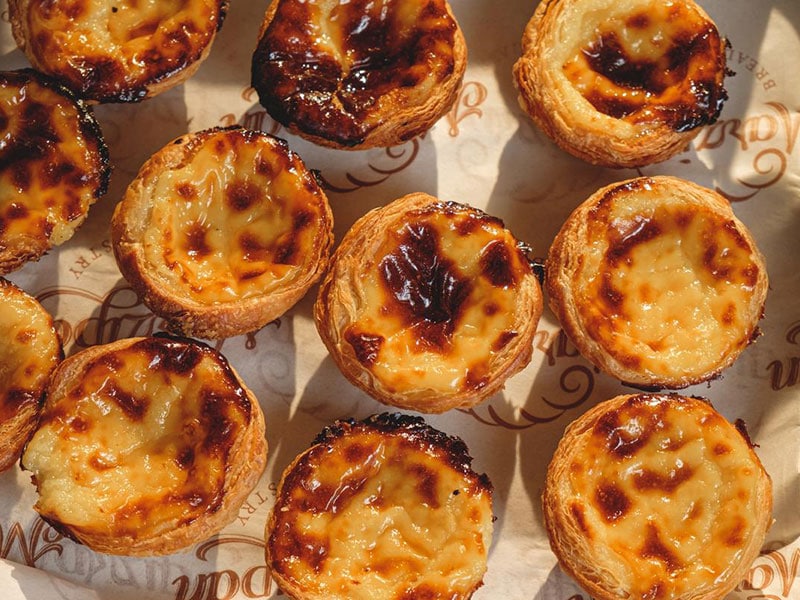
The story of Pastel de Belém, or Pastel de Nata, begins with monks at Lisbon UNESCO-listed Jeronimos Monastery.
Displaced by the 1820s revolution, they turned to baking as a livelihood. The need to starch their clothing with egg whites left them with an abundance of yolks, which they used to create these delightful custard tarts.
Pastel de Belém, as it’s known in its birthplace, and Pastel de Nata, as it’s referred to everywhere else, are fundamental items in bakeries and coffee shops across Portugal.
These popular pastries have also made their way into Western Europe and Asia, as well as the former Portuguese colonies of Macau and Brazil.
The buttery, crispy filo dough filled with egg custard, akin to creme brulee, is made with simple ingredients: flour, butter, eggs, cinnamon, and powdered sugar. Served warm, alongside bica – Lisbon’s version of espresso – it’s a taste of Portuguese heritage in every bite.
33. Polvo à Lagareiro (Octopus With Potatoes)
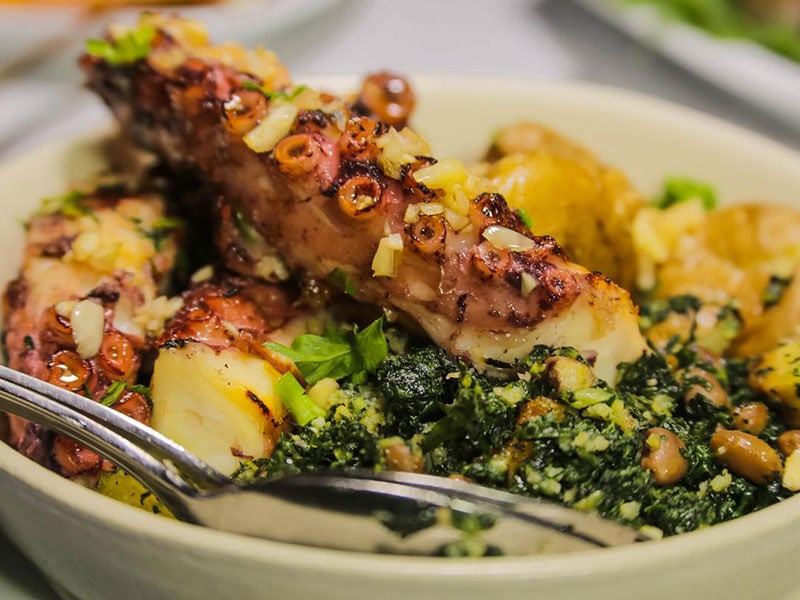
Hailing from the medieval Beira province, Polvo à Lagareiro is a festive Portuguese dish, often gracing tables on Christmas Eve.
This dish features octopus, prepared in a variety of ways – it can be boiled, baked, or grilled and is served together with crushed potatoes. What truly elevates the dish is a generous drizzle of extra-virgin olive oil and a sprinkling of herbs and garlic.
34. Bacalhau à Brás (Salt Cod With Potatoes & Eggs)
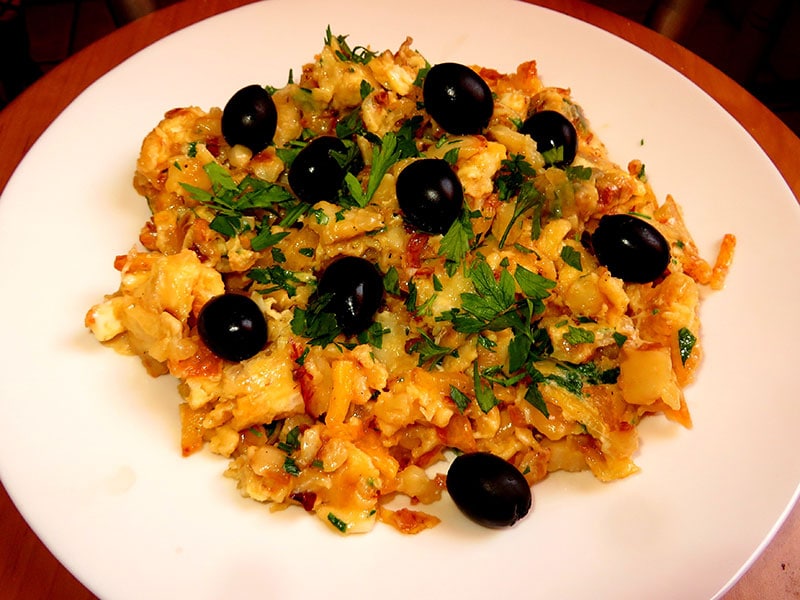
Bacalhau à Brás, Portugal’s national dish, is a delightful creation of an innkeeper named Brás from Lisbon’s Bairro Alto neighborhood. It’s a special preparation of cod, which is soaked overnight to extract the salt.
The cod is then flaked and artfully combined with scrambled eggs, sautéed onions, potato strips, garlic, and an assortment of spices, delivering a rich medley of flavors. And, for the finishing touch, a sprinkle of olives and parsley.
35. Cataplana (Pork And Seafood Stew)
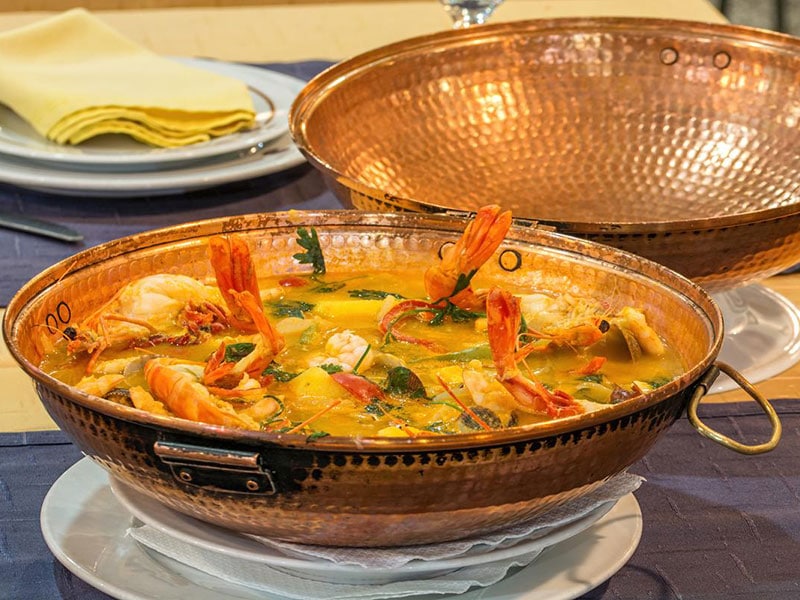
Cataplana, a savory fish stew, is a culinary symbol of Algarve in Portugal. This dish also shares its name with the distinctive cookware used in its preparation, which resembles two clamshells.
The flavors in Cataplana are as versatile as its ingredients – pork, chouriço sausage, fish, shrimp, or other seafood, married with olive oil, tomatoes, chili pepper, garlic, and herbs. There are two main versions: one spotlighting seafood, while the other combines pork and clams.
Cooking in the Cataplana cookware is straightforward, requiring only layering of ingredients and closing the pan, no stirring needed. This simplicity of preparation retains the rich flavor and freshness of the ingredients.
Paired with white rice, bread, or fried potatoes, Cataplana serves up an authentic taste of Portugal’s coastal cuisine.
36. Cozido à Portuguesa (Mixed Boiled Dish)
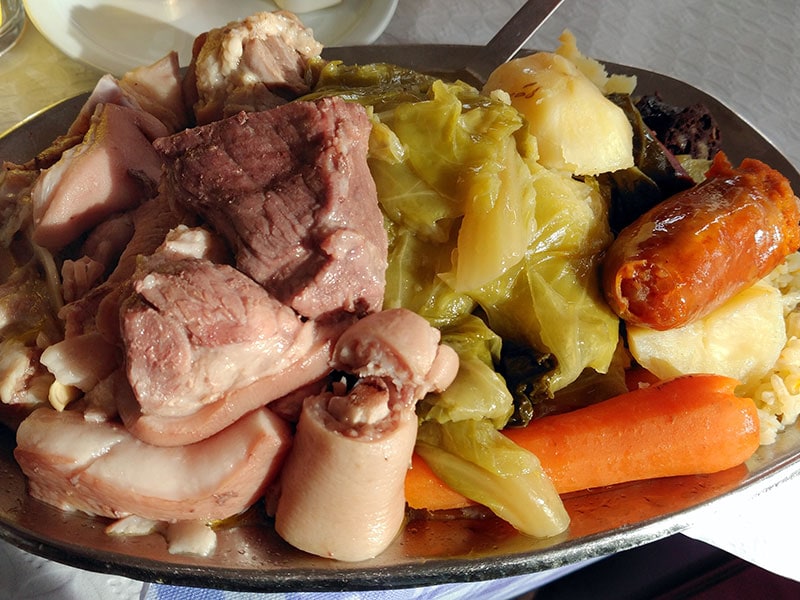
Cozido à Portuguesa, affectionately known as Portuguese Cozido, is a gem in Portugal’s culinary crown. As one of the country’s national dishes, it bears the legacy of Portuguese heritage.
This nutrient-packed meal offers a medley of meats like chicken, bacon, pork, and beef, joined by an abundance of vegetables such as cabbages, potatoes, beans, and turnips. Its twist comes from incorporating various types of sausages like chouriço, farinheira, and morcela.
All these ingredients harmoniously cook in a flavorful broth and are served beside cornmeal porridge, bread, or rice. Cozido à Portuguesa is a frequent star at festive or celebratory meals and warming comfort food during the colder months.
From one Portuguese restaurant to another, Cozido à Portuguesa offers various variants. Whether cooked at home or tasted in Furnas in the Portuguese Azores, every version of this dish is worth a try.
37. Frango no Churrasco (Barbecued Chicken)
Frango no Churrasco, translated as “chicken on the grill,” is a cornerstone of Portuguese cuisine, especially as a popular Portuguese street food item to locals and tourists. This beloved dish features a whole chicken, enticingly spiced and cooked directly on the grill.
The marinade is a flavorful blend of paprika, fiery piri piri sauce, garlic, olive oil, and lemon. The juicy, barbecued chicken is traditionally served with rice or French fries as a side dish. Stroll through Lisbon’s hilly streets, and you’ll easily find this aromatic dish being savored at local eateries.
38. Pão de Ló (Portuguese Sponge Cake)

A staple of Portuguese cuisine since the 1700s, Pão de Ló is a traditional sponge cake that exudes simplicity and elegance. Crafted using basic ingredients like flour, sugar, and eggs, the cake may also feature a dash of lemon zest, salt, or baking soda for an added touch of flavor.
Pão de Ló isn’t limited to a single version; variants abound, such as the Pão de Ló de Ovar, renowned for its creamy texture, and the Pão de Ló de Margaride, recognized by the distinct hole at its center.
The defining attribute of this cake, however, is its moisture content and fluffiness. Baked until it achieves a slightly golden hue, Pão de Ló can be embellished with toppings like jam or whipped cream.
39. Francesinha (Portuguese Sandwich)
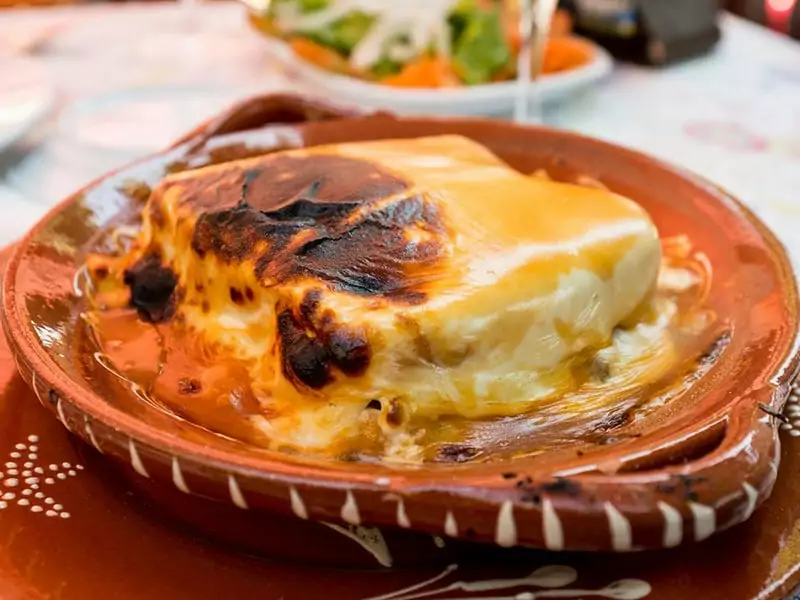
Francesinha, translating to “little French woman,” is a beloved sandwich hailing from the Porto region of Portugal. This hefty delicacy features an impressive layering of meats such as steak, wet-cured ham, and sausage, all enrobed in cheese and topped off with a fried egg.
The sandwich doesn’t stand alone; it is traditionally served with an accompaniment of plentiful French fries and drenched in a warm, reddish-brown sauce. This distinctive sauce is a blend of piri piri spice, beer, and tomato.
Francesinha isn’t rigid in its creation; different chefs bring their unique techniques to its preparation, offering variations on this classic. Rich and robust in taste, Francesinha is more than a simple sandwich—it’s a hearty, fulfilling meal.
40. Bifana (Pork Sandwich)
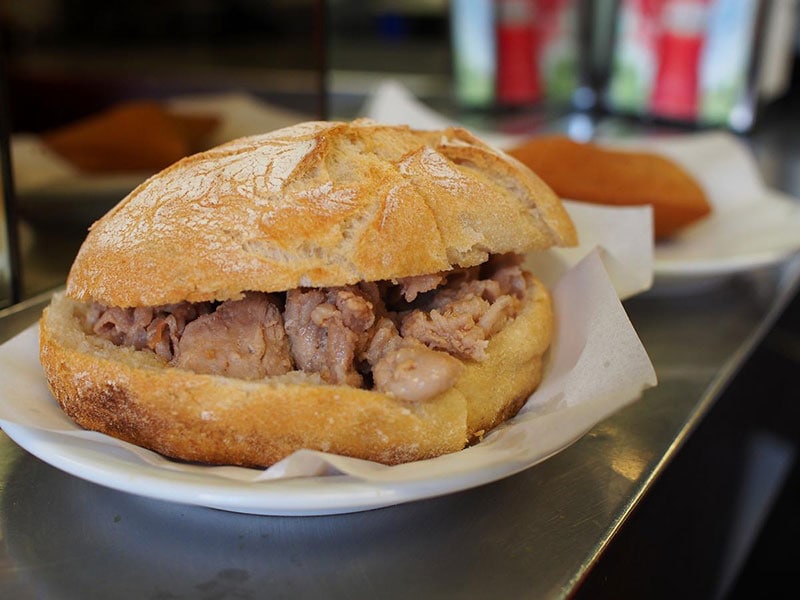
Bifana, the essential Portuguese pork sandwich, is simple yet irresistibly tasty. It’s the beauty of a Papo Secos bread roll cradling tender, thin slices of marinated pork that seals the deal. The secret to its unforgettable taste lies in the marinade, a mix of garlic, paprika, and white wine.
It’s fascinating to observe regional variations too; the north opts for passata in the marinade, while the south leans towards white wine. Whether it’s a cutlet, small pieces, or shredded pork, the meat always adds a satisfying texture.
Local cafés and snack bars across Portugal serve Bifanas at affordable prices, making them a popular grab-and-go snack. To amp up the flavor, it’s typically enjoyed with piri piri sauce or mustard.
41. Amêijoas à Bulhão Pato (Portuguese Clams)
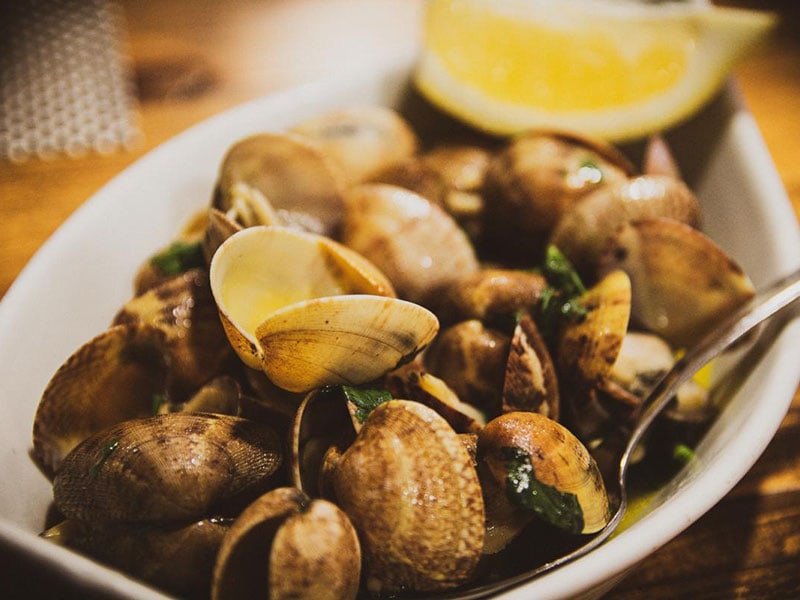
Amêijoas à Bulhão Pato, an out-of-this-world clam dish, carries the name of Raimundo António de Bulhão Pato, a revered Portuguese poet.
This dish has its roots firmly planted in the culinary traditions of Lisbon, the lively capital of Portugal. Located where the Atlantic Ocean converges with the River Tagus [4], the region offers an abundance of seafood, which is prominently featured in the cuisine.
It’s not uncommon to stumble upon this delicacy in The Algarve too, a region where seafood holds a prominent place on the menu. The recipe revolves around clams bathed in a robust sauce made from olive oil, garlic, cilantro, white wine, and seasonings.
To truly appreciate Amêijoas à Bulhão Pato, it’s recommended to accompany it with quality bread, perfect for soaking up the flavorsome sauce. Usually served as an appetizer, this dish is a tribute to Portugal’s rich maritime bounty.
42. Porco Preto (Black Iberian Pig)
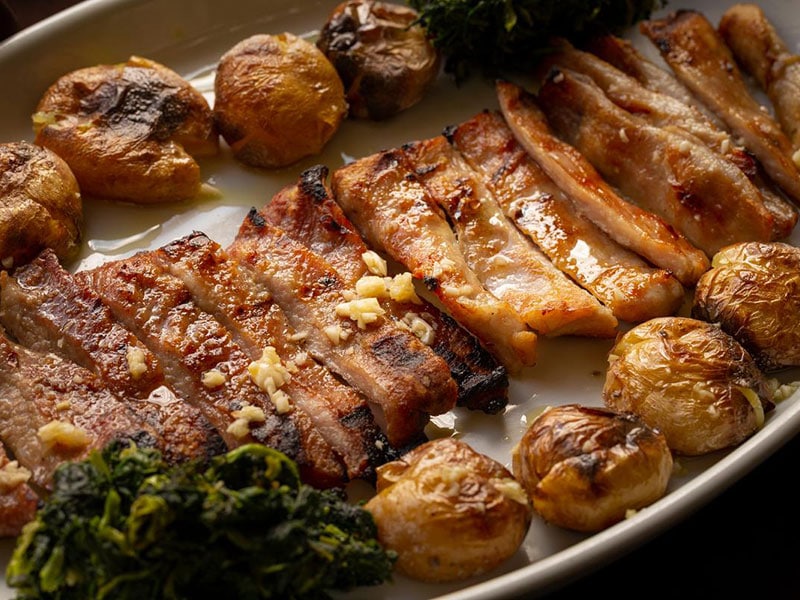
Porco Preto is a culinary icon from the Iberian Peninsula that has gained international recognition.
Its quality meat is highly prized in Portuguese cuisine, particularly in the southern regions where the ecological conditions are ideal for these animals, with the Alentejo countryside standing out.
I got the chance to try Porco Preto com Molho de Alho, a dish featuring dark pork loin in garlic. The tender, melt-in-your-mouth texture and the nutty flavor are something to remember.
Such a savory profile comes from their diet, which includes plenty of acorns. Presunto Porco Preto, the local version of Spain’s Jamon Iberico, is another delicacy that has me hooked.
With a slightly higher fat content than regular pork, this top-quality meat, although a bit pricey, is surprisingly healthier.
Italian
43. Pasta

In the world of Italian cuisine, pasta holds an indisputable place. I remember my first encounter with this staple food, made typically from milled durum wheat flour, eggs, and water.
The myriad of shapes it came in was fascinating – I learned that there are around 310 specific forms. From the long, cylindrical spaghetti to the stuffed wonders that are ravioli. Fresh or dried, every kind of pasta tells its own story.
Pasta fresca, the fresh variant, gave me a different experience compared to pasta secca, the dried variant. Each kind, cooked to perfection, was like a blank canvas waiting to be painted with numerous types of pasta sauce or condiments.
My favorite is the Ragu Alla Bolognese – a rich concoction of browned meat, tomatoes, and Italian spices, that transforms plain spaghetti into a dish of comfort and satisfaction.
In Southern Italy, pasta dishes adorned with vegetables, seafood, olives, and capers introduced me to another spectrum of flavors. Some versions of pasta are served in broth, especially the tiny variants, adding another delicious twist.
Some of the most well-loved pasta dishes include lasagna, spaghetti Bolognaise, and creamy pasta Carbonara.
44. Risotto
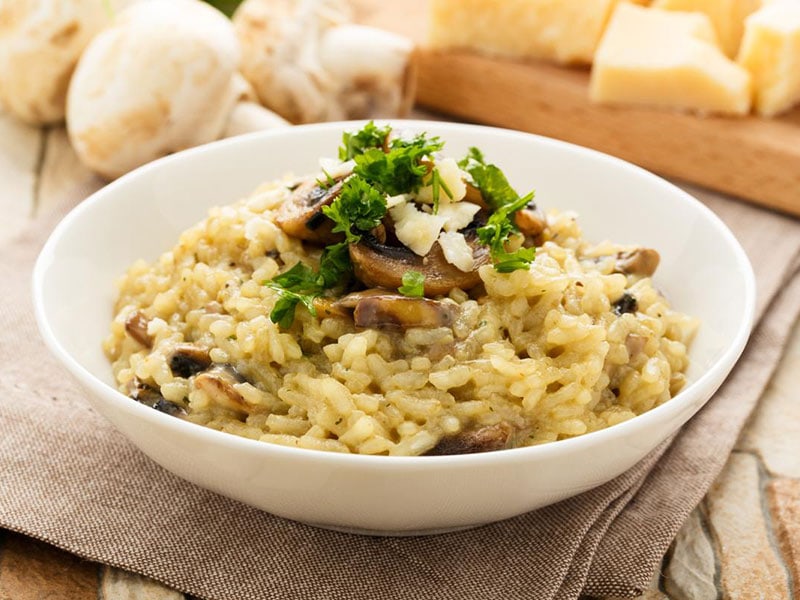
Risotto, a comforting Italian rice dish, has its own distinctive allure. A special variety of rice, often short-grain carnaroli or arborio, serves as the main ingredient. The rice is simmered gently on a low heat with a well-seasoned broth, which can be made from meat, fish, or vegetables.
This slow cooking process allows the rice to absorb all the beautiful flavors and transform into a creamy, sticky delight. During cooking, the fragrant aroma of sautéed onion, the tang of white wine, and the richness of butter merge beautifully with the rice.
Vegetable or mushroom variants further enhance the flavors. While many risotto recipes exist, I love each and every one I have tried. Before the main course, risotto often graces the table as the first course. But don’t be surprised to see it as a side dish, complimenting meaty or seafood dishes.
45. Pizza

In Italy, pizza is more than just food; it is a cultural institution. An impressive total of one million pizzas are consumed daily in the country. Each pizza variety consists of a round, leavened, wheat-based dough base and an assortment of toppings.
Frequent topping choices range from sausage and cheese to tomatoes and ham, among others. However, pizza’s character varies greatly, shifting from one region or pizzeria to another. An intriguing aspect lies in the crust’s thickness.
The further you travel north in Italy, the thinner the crust you encounter. This dish undergoes a baking process in a high-temperature, wood-fired oven, contributing to its distinct taste.
Traditionally in Italy, pizza is served unsliced, prompting the use of a knife and fork instead of the casual approach of using hands or pizza cutters for dividing the pizza into triangular portions.
It’s essential to note that in Italy, requesting fruit toppings (specifically pineapple) on pizza is a faux pas. Furthermore, dipping pizza in tomato ketchup is not a thing in Italy.
46. Lasagne / Lasagna
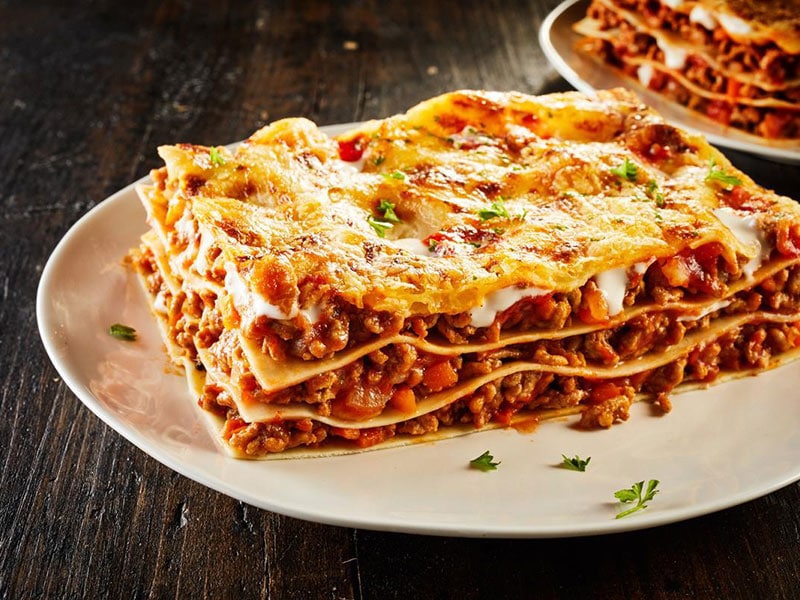
Lasagne, or lasagna as known in America, carries dual identities. It’s a broad, flat pasta type, and also a comfort food composed of this pasta, stacked in layers with hearty fillings nestled in between. Also, the layering technique of lasagne is relatively easy to master.
Traditional lasagne recipes pull in ground beef and tomatoes to make a savory ragù sauce, and a variety of cheeses, which could be parmesan, ricotta, or mozzarella. A fine dusting of grated cheese on top seals the deal.
Other variants offer a rainbow of vegetables or an extravaganza of cheeses. For an aromatic touch, chopped sage, thyme, or rosemary might mingle with your homemade dish. This comfort food is usually baked in the oven and served hot, portioned out in pleasing squares.
Fun fact: the difference in spelling – ‘lasagna’ or ‘lasagne’ – depends on which side you’re on, American or British, respectively.
47. Tiramisu
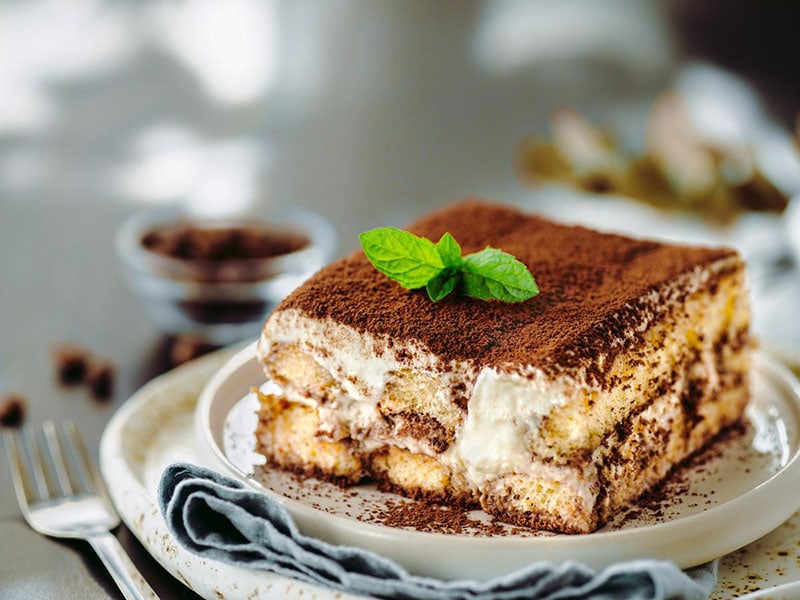
Tiramisu is an Italian dessert icon, loved for its coffee-infused flavors and effortless no-bake method. A mosaic of ladyfingers, espresso, and a fluffy mixture of eggs, sugar, and mascarpone cheese create this luscious sweet course.
A touch of Marsala, a fortified wine, can lend an additional flavor dimension. The process is quite straightforward: Ladyfingers take a quick dip in espresso, layered with the airy mascarpone mixture, and a dusting of cocoa powder crowns the assembly.
Slight sweetness meets coffee undertones in every bite, while its texture strikes a harmonious balance between light, creamy, and soft. Tiramisu is a patient dessert, taking at least six hours before serving to allow flavors to deepen and mingle.
A word of caution – a prolonged soak of ladyfingers in coffee could lead to a soggy outcome. The best way to serve Tiramisu is either chilled or at room temperature.
48. Focaccia
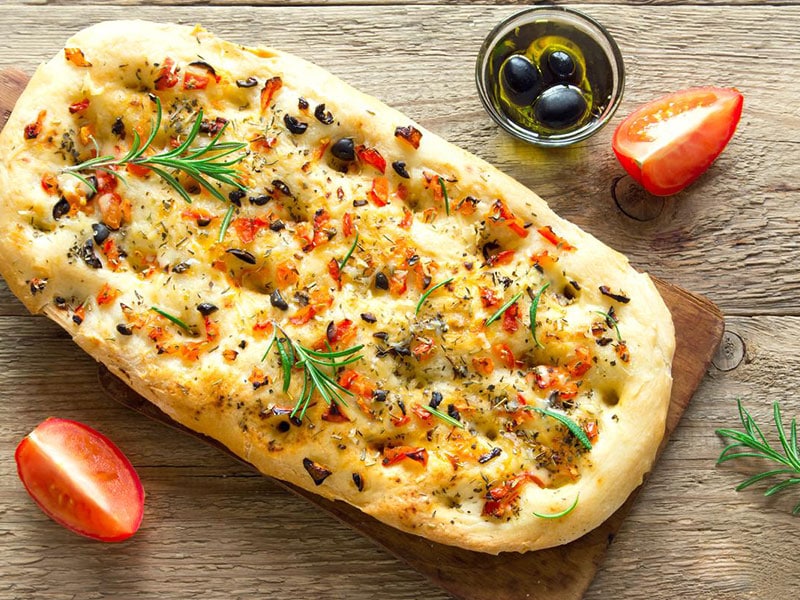
Meet Focaccia, a revered flatbread hailing from Italy. Made from leavened dough consisting of flour, water, olive oil, yeast, and salt, it mirrors pizza in both style and texture. Focaccia often boasts a beautiful topping landscape of herbs, such as rosemary, olives, and cheese.
This results in an irresistible crust that’s crisp and salty, which opens up to reveal a slightly chewy interior. It serves diverse roles, from a companion to sausage and cheeses to the starring role of sandwich bread.
In Genoa, a unique breakfast ritual involves dipping Focaccia into espresso. With the freedom to take on round, rectangular, or square forms, and regional variations, it’s a bread of many faces. Beware, though, as its rich olive oil content renders it higher in calories and fat than regular bread.
49. Arancini (Rice Balls)
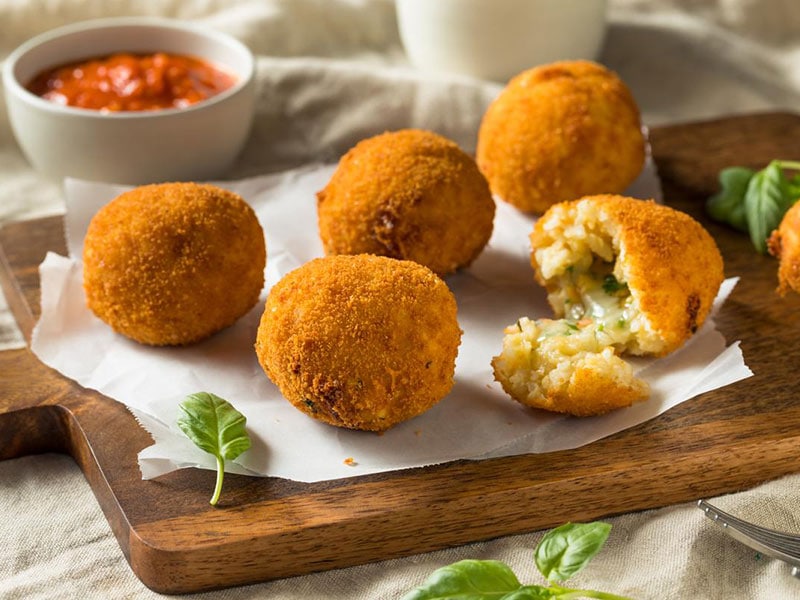
Among my treasured memories from Sicily is the unforgettable Arancini. These little beauties, star players in Sicilian and broader Italian cuisine, are a fixture of the bustling street food scene.
Arancini are deep-fried balls meticulously crafted from rice and stuffed with various fillings. Classic combinations include ragù, cheese – mozzarella or caciocavallo, to be exact – and occasionally peas, all beautifully encased in a crispy breadcrumb coating.
Sicilian café shops masterfully prepare two major variants: arancini al ragù and arancini cû burru, the latter featuring butter or a silky béchamel sauce. They’re served ideally with salad or vegetable sides or a simple yet flavor-packed sauce.
50. Prosciutto
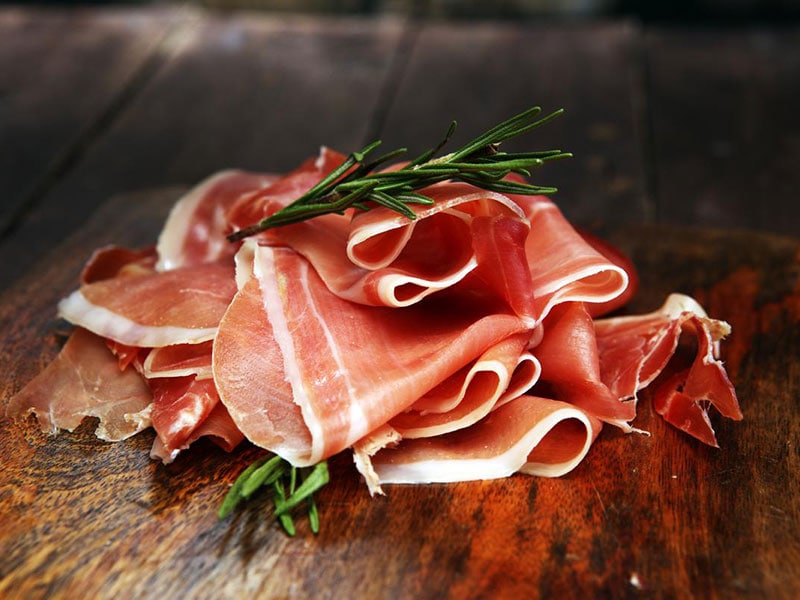
In Italy, “Prosciutto”, which translates to “ham”, serves as a key aspect of the culinary culture. It is made from high-quality pork legs and aged through a dry-curing process.
Prosciutto comes in two primary forms: prosciutto cotto, which is cooked, and prosciutto crudo, a cured but uncooked variety. Both offer a distinct flavor experience.
Notably, prosciutto is not smoked, and prosciutto crudo is usually served in thin slices. There are specific variations, such as Prosciutto di Parma DOP and Prosciutto di San Daniele DOP, which are particularly celebrated in Italian gastronomy.
These versions are distinguished by their unique flavor characteristics. Prosciutto can be enjoyed in numerous ways, whether incorporated into different dishes or savored on its own.
Locals usually wrap it around cheese, skewer it with olives, and pair it with fresh fruits, presenting an incredible range of taste experiences. It became the hero topping for salads, sandwiches, pizzas, and pasta sauces.
51. Ribollita (Tuscan Bread Soup)
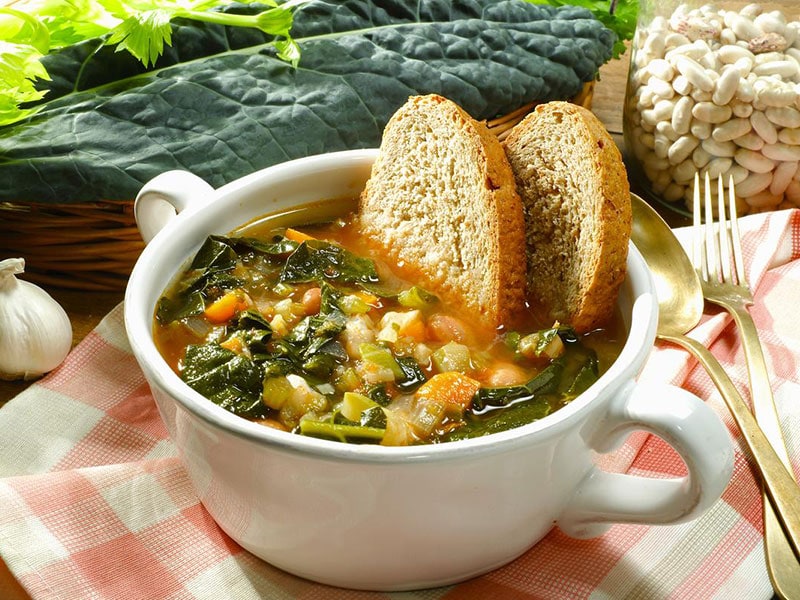
Ribollita, or “reboiled”, hails from Tuscany, representing the ingenuity of turning leftovers into something soul-satisfying. This soup blends bread, a medley of vegetables like carrots, beans, celery, potatoes, and cannellini beans.
It’s a tradition, really, rooted in reheating vegetable soup from the day before, tossing in stale bread to give it new life. Today, that spirit of repurposing bread lives on.
What strikes me most about Ribollita is its flavorful, chunky texture, and how it embraces you with warmth on a cool night. One of my fondest memories is savoring this hearty, economical soup, a glass of red wine in hand.
52. Bistecca alla Fiorentina (Italian Steak)
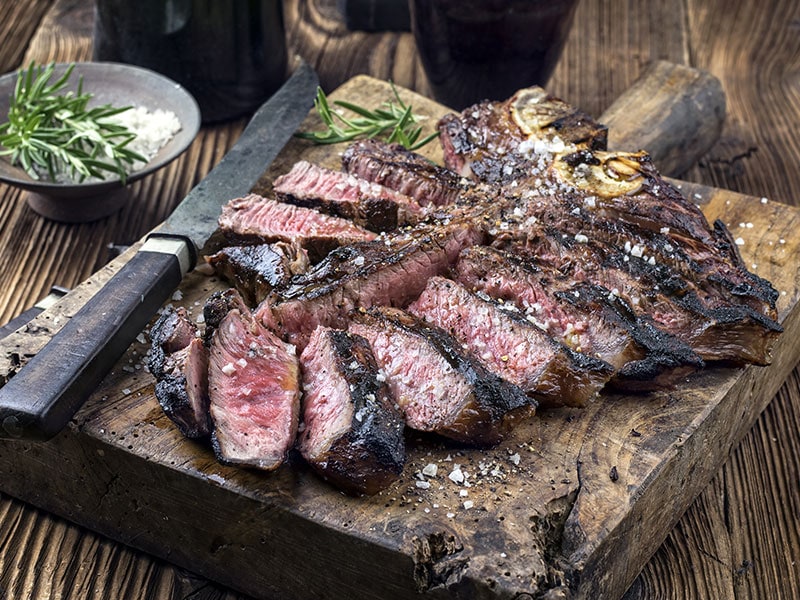
In Tuscan cuisine, Bistecca alla Fiorentina, also known as Florentine Steak, is an iconic piece of steak popularly served around the world. Traditionally, it’s made with the Chianina, a Tuscan breed of cattle, lending it a distinctive flavor.
The ideal cut for this preparation is the bone-in sirloin, creating a hearty, generous serving. It’s seasoned with the simplest of ingredients – olive oil, salt, pepper, and rosemary – each playing its part to accentuate the meat’s natural flavors.
Cooking it is an art in itself; it’s grilled either directly on the embers or on a grill. The authenticity of charcoal enhances its flavor; thus, using plates, gas grills, or electric grills is not recommended.
On a personal note, what I found equally appealing are its traditional accompaniments. A fresh salad or cannellini beans dressed in olive oil complement the steak wonderfully. To elevate the experience, a glass of red wine is a perfect pairing.
53. Panzanella / Panmolle (Tuscan Tomato and Bread Salad)
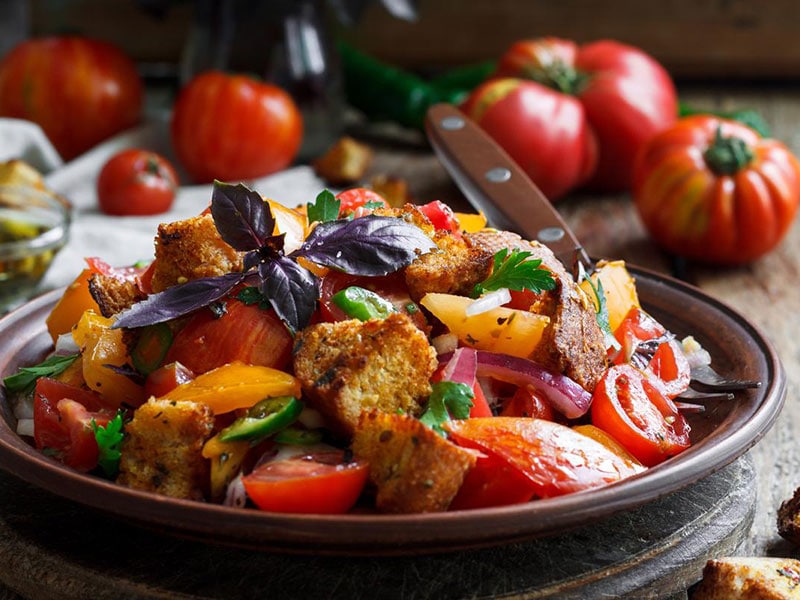
One summer dish that brings back Tuscan memories for me is Panzanella, also known as Panmolle. It’s a rustic salad primarily composed of stale, dried bread, tomatoes, and onions.
All you have to do is mix cubed ingredients in a large bowl, toss well with a tangy dressing, and there you have it – a taste of summer that is as fresh and pleasant as the season itself. You can make it a few hours in advance, letting the flavors meld together at room temperature.
As a side dish, Panzanella pairs perfectly with a variety of mains, whether it’s roasted chicken, pasta carbonara, or spaghetti and meatballs.
54. Bruschetta (Italian Antipasto)
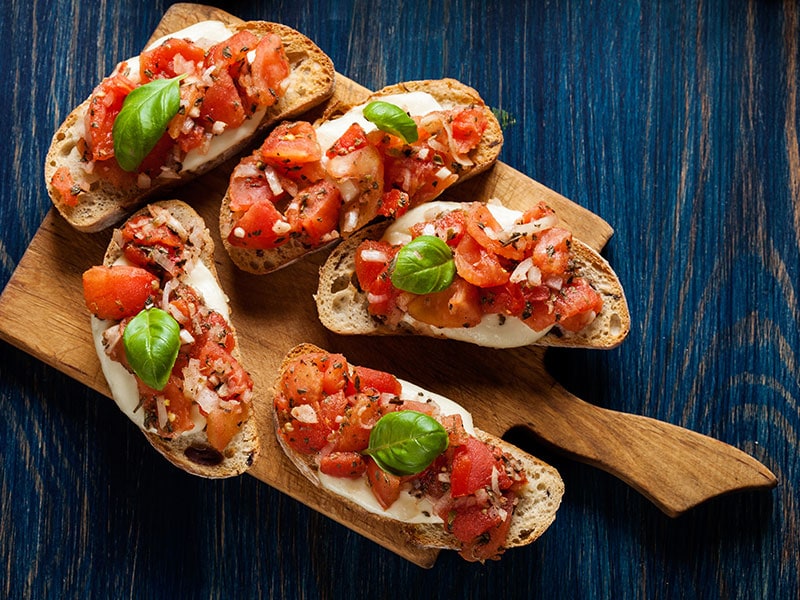
When I think of Italian Antipasto, one dish that always comes to mind is Bruschetta. It’s a simple, flavorful dish where toasted bread plays the leading role, joined by ingredients such as garlic for rubbing, and olive oil and salt for topping.
The joy of Bruschetta is in its variations – some with tomatoes, others with cured meat or shredded cheese. Served cold, it makes for an appetizing start to an Italian meal or a light, enjoyable snack.
Choosing the right bread is crucial here. I’ve found that ciabatta, pagnotta, or French bread work best. The term “bruschetta” itself comes from the Italian word “bruscare,” meaning “to roast over coals,” paying homage to its traditional preparation method.
Interestingly, Bruschetta is distinct from Crostini, which uses smaller, finer-textured bread, like a baguette, typically brushed with olive oil.
55. Cannoli (Tube-Shaped Pastry)

Sicily gifted the world a gem of a dessert – the Cannoli, arguably one of its most recognized pastries. Its heart lies in a tube of fried pastry dough, made from eggs, flour, butter, and sugar, which is then generously filled with creamy sheep’s milk ricotta.
The result is a pastry with a distinctive contrast – a cylindrical crispy shell housing a sweet, soft filling. Before serving, some adorn Cannoli with crushed pistachios or a dusting of powdered sugar, adding to its allure.
I’ve found that the size and filling ingredients can vary across Sicily, each region offering its unique take. However, a word of caution – as much as I adore Cannoli for its taste, it’s not the healthiest choice given its high fat, sugar, and calorie content.
56. Polenta (Cornmeal Dish)
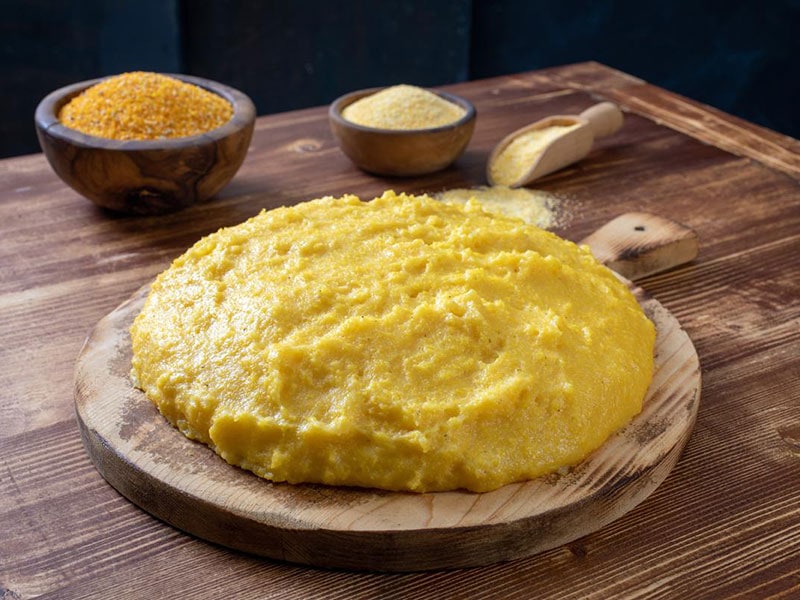
Hailing from Northern and Central Italy, Polenta, a time-honored Italian dish made from boiled cornmeal, claims its place as one of the oldest recipes in history. I’ve always been fascinated by its bright yellow color, a nod to its corn origins.
The flavor possesses a mild sweetness inherent to corn, which always warms my palate. Freshly cooked polenta presents a soft, creamy texture, morphing into a more hardened state as it cools down.
Its versatility shines when served hot as porridge or employed as a stand-in for rice or mashed potatoes. There’s nothing quite like a generous helping of polenta adorned with a savory sauce or sprinkled with cheese, and it perfectly complements a hearty stew.
Now, polenta cake paired with Parmigiano-Reggiano cheese and baked is a creation that always makes me smile. And let’s clear up a common misconception: it’s not the same as grits. Polenta uses yellow corn, while grits come from white corn.
57. Ossobuco / Osso Buco (Braised Veal Shank)
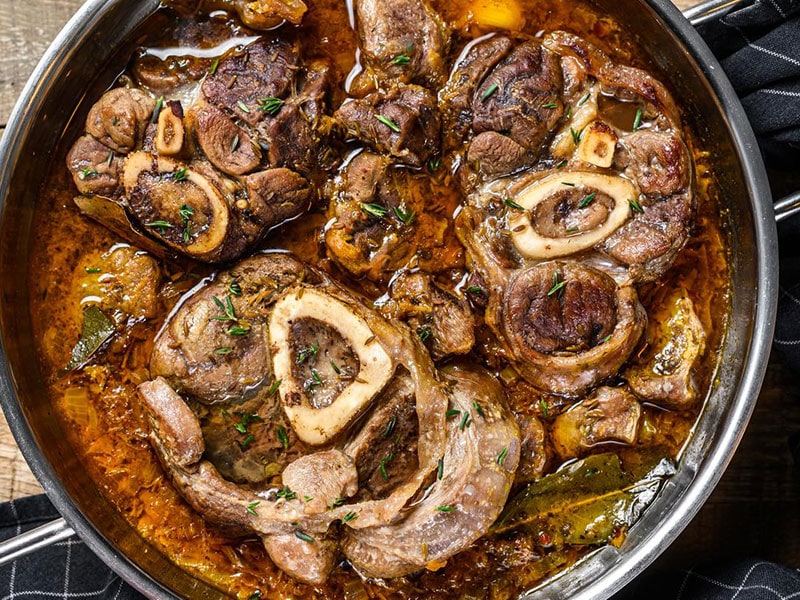
Osso Buco, a joy of Lombard cuisine, showcases cross-cut veal shanks prepared with white wine, vegetables such as carrots, and spices including bay leaf and cinnamon. This all gets simmered together until the veal turns beautifully tender.
And let’s not forget the ‘bone with a hole’, a quirky name that refers to the marrow hole in the bone or cross-cut shank. Traditionalists will tell you Osso Buco doesn’t include tomatoes, sticking to time-honored methods.
When it comes to serving, this braised masterpiece frequently finds its place next to polenta, risotto alla milanese, or mashed potatoes, all excellent companions. Rich and savory in flavor, Osso Buco offers a profoundly meaty taste that permeates every bite.
58. Gelato

Gelato, Italy’s answer to ice cream, is a marvel of creamy goodness. It dominated the European culinary scene, producing a staggering 595 million liters a year in 2016 [5].
It’s crafted from a mix of milk, heavy cream, sugar, and various flavorings derived from nut purees or fruit. With butterfat content sitting at around 6%–9%, Gelato is a slightly lighter frozen treat.
But don’t mistake this for lack of indulgence, as this marvelous Mediterranean treat unfurls a smooth texture that simply melts in the mouth. Containing about 35% air, Gelato has a density that lends itself to perfect scooping.
My pro tip for your Gelato quest in Italy: bypass any unnaturally bright colors and search for signs like “gelato in casa” or “gelato artigianale” signaling artisan, homemade quality.
My go-to flavors is Fior di latte for its creaminess, the depth of cioccolato fondente, nutty pistacchio, and refreshing limone.
59. Gnocchi
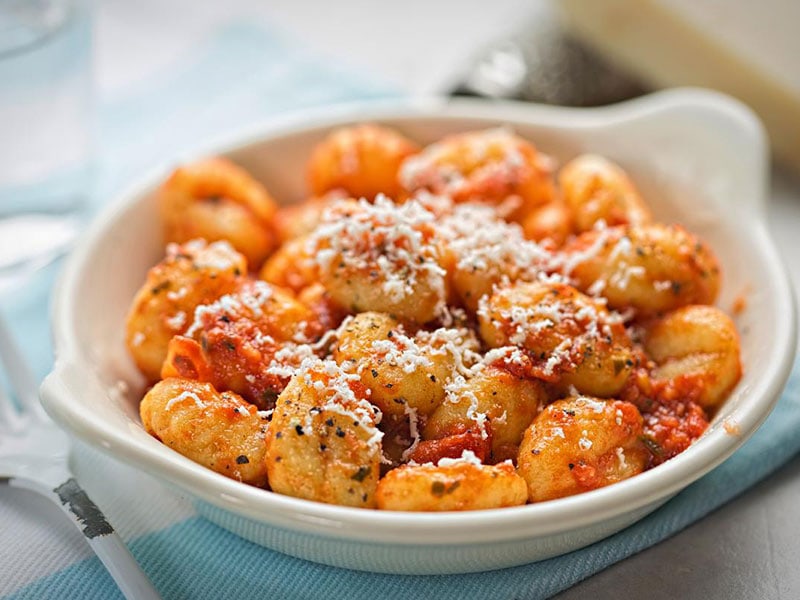
Meet Gnocchi, an Italian gem, served as a delightful dumpling crafted from potato, wheat flour, and a touch of salt. Some recipes even call for an egg for added richness. Once kneaded, they’re typically fashioned by a gnocchi board to flaunt those characteristic tiny ridges.
No gnocchi board? No problem. A simple fork can also do the trick! Just like pasta, gnocchi is boiled in salted water, turning from submerged to floating in mere minutes – a quick 2 to 4 to be exact.
Freshly cooked gnocchi brings forth a unique texture, a blend of squidgy and smooth, avoiding the pitfall of mushiness. The versatility of gnocchi is another highlight. It welcomes a variety of sauces, from sage and butter to basil pesto or even beef ragù.
Whether served as an entree, a side, or the star of the show, gnocchi always pleases the palate.
60. Panini

Panini, a true Italian sandwich, encapsulates a delightful blend of ingredients nestled between slices of traditional Italian bread, such as michetta or ciabatta. Building your own panini is a culinary journey.
Selecting layers of meat or ham, assorted veggies, and your favorite cheese, allows for a personal touch. The real transformation happens when your assembled panini gets to know the heat of a grill.
Pressed between hot grills, it’s rewarded with a crispy crust and those irresistible grill marks on the bread’s surface. The heat also works wonders on the cheese, melting it into a gooey masterpiece that oozes with every bite.
Serve up your panini with a side of tomato soup, potato soup, or potato fries and you’ve got yourself a satisfying meal.
61. Frittata

Frittata, an Italian favorite, is an egg-based dish that’s akin to an omelet, but with a few delightful differences. Where an omelet is all about high heat and speed, a frittata takes its time, basking slowly over a low flame.
It’s not in a rush, it’s quite happy to be served either warm or cold. And why wouldn’t it be? A frittata isn’t just eggs, it’s a canvas for other tasty ingredients too. When craving meat, vegetables, or cheese, don’t hesitate to toss them into your frittata for an extra burst of flavor.
If you prefer a fluffier and creamier texture, adding a bit of milk or cream is an excellent solution. Enhance the flavor further by garnishing with a selection of herbs.
If you’re not keen on using the stovetop, there’s no need to worry; the oven serves as an ideal environment for preparing a frittata. This adaptable dish, similar to a crustless quiche, can make a notable addition to both your breakfast and dinner tables.
62. Minestrone
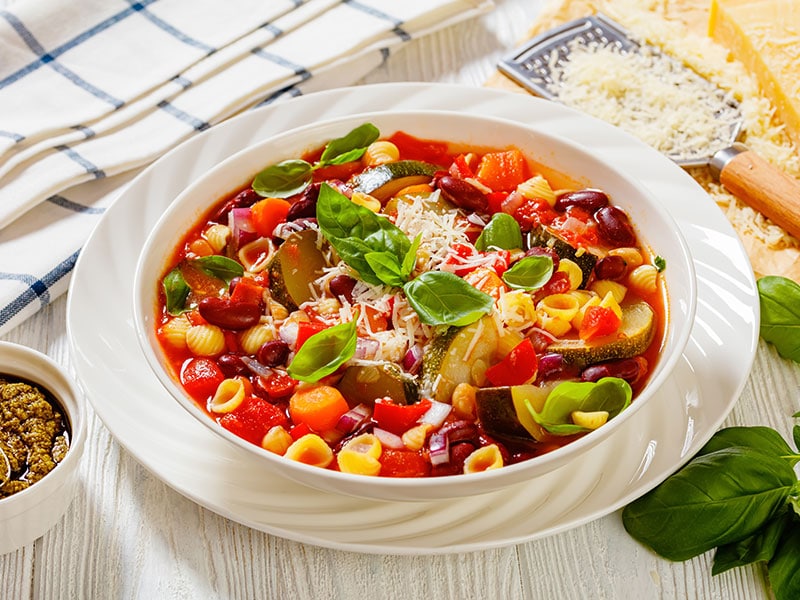
Minestrone, a classic Italian dish, is a thick soup teeming with vegetables such as beans, tomatoes, celery, and carrots, all simmered gently in a rich stock. This medley can be tailored to your preference.
You can even throw in small pasta or rice for a hearty touch. The magic lies in the Italian seasonings or spices that enhance the flavor profile. Don’t be surprised to find regional variations too.
Minestra, for instance, includes tomato paste, while Minestrone alla Genovese boasts a generous mix of herbs. This healthy soup forms a delightful pairing with sides such as garlic bread, bruschetta, or baked potatoes, promising a satisfying meal.
63. Zabaglione

Zabaglione is an Italian delicacy that blurs the line between a custard-like dessert and a beverage. Its core ingredients include egg yolk, sweet wine (preferably Marsala or passito), and sugar, creating a flavor fusion of rich custard and refined wine.
For a lighter touch, it can be topped off with beaten egg white or whipped heavy cream, and perhaps a sprinkle of strawberries or raspberries. When preparing Zabaglione, a double boiler is the tool of choice.
The custard mixture is whisked diligently until it thickens into a smooth texture. Although it’s usually savored warm, serving it cold is also an option for those sweltering summer days.
64. Pesto
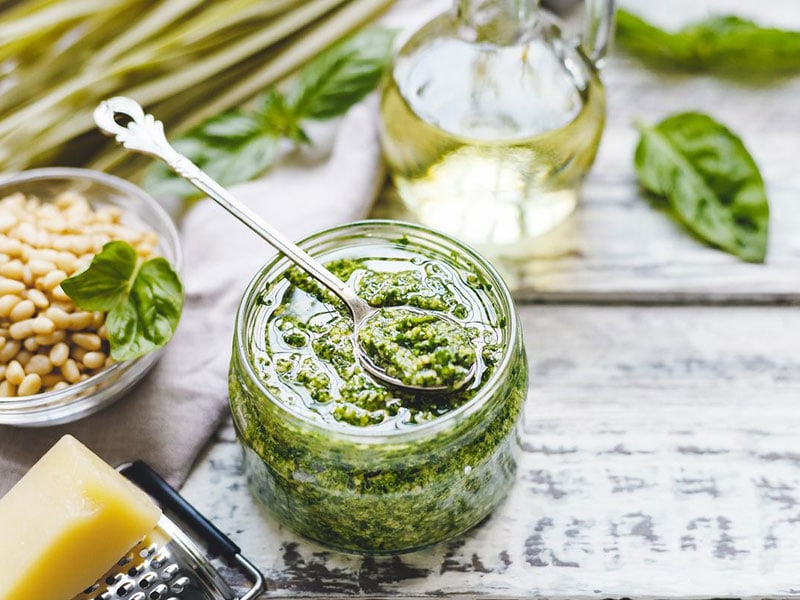
Pesto, the classic Italian sauce that’s as flavorful as it is versatile. It’s a beautiful blend of basil, pine nuts, olive oil, and grated cheese, seasoned to perfection with a pinch of salt and a touch of garlic.
The sauce is a striking green concoction with a robust garlicky, and nutty taste that can elevate any dish it graces. While making the sauce at home, you may wonder if pesto can turn bad because of many elements. Don’t worry, I’ll let you in on the secret for a perfect pesto.
My secret ratio for a flawless pesto is eight leaves of basil, two parts of oil and cheese, and 1.5 parts of nuts. With this formula, you can never go wrong.
One bite, and you’re transported straight to the heart of Italy. I’ve used a blender or a food processor to make it, but I’ve found that a mortar and pestle can impart a unique rustic texture and taste that’s incredibly satisfying.
I adore pesto for its versatility. I’ve tossed it with pasta, drizzled it over meat dishes like steak or seafood, and even used it as a dip for veggies or bread. One creative way I enjoy my pesto is by blending it with Greek yogurt or sour cream to create a vibrant spread.
It’s not just a flavorful addition to your meals but also packs a nutritional punch with potential health benefits. It can even reduce the risk of diabetes, heart problems, and cancer.
Spanish
65. Paella
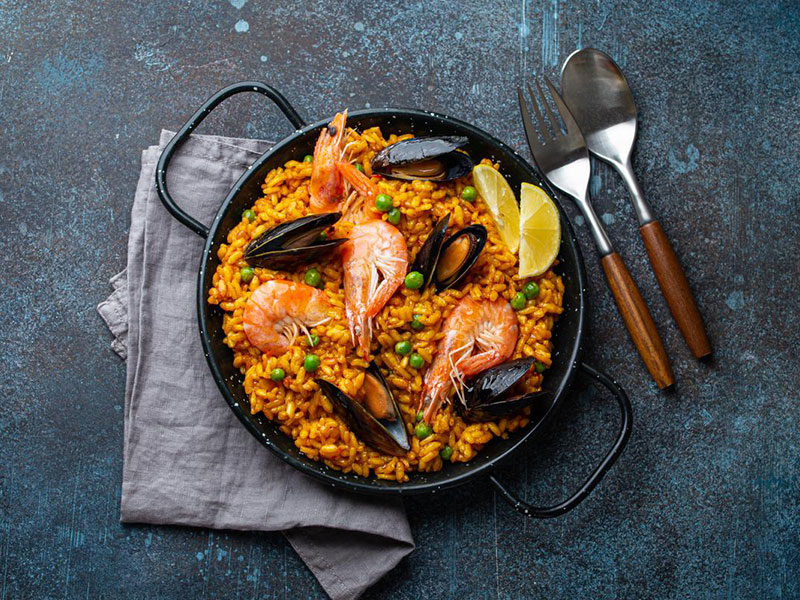
Paella, a renowned rice dish, hails from the Valencian Community. Its roots trace back to the Albufera lagoon, where it served as a hearty lunchtime meal for farmers and laborers. I have a soft spot for Paella Valenciana, the traditional version of the region.
Let me paint a picture for you. The Spanish delight is prepared in a wide, shallow traditional pan, aptly called ‘Paella.’ The pan is placed over an open fire, fueled by orange and pine branches, even pine cones. The subtle scent of burning wood infuses the dish, imparting an unparalleled rustic charm.
Now, let’s talk about ingredients. Meat, usually chicken, rabbit, snail, or duck, forms the protein base. Butter beans, great northern beans, runner beans, and artichokes bring an earthy note, while seafood adds richness. Tomatoes lend vibrant color and a slight tang.
And, of course, the star of the show – rice, is imbued with the golden hue of saffron, its subtle flavor weaving through every bite.
66. Tortilla Espanola (Spanish Omelet)
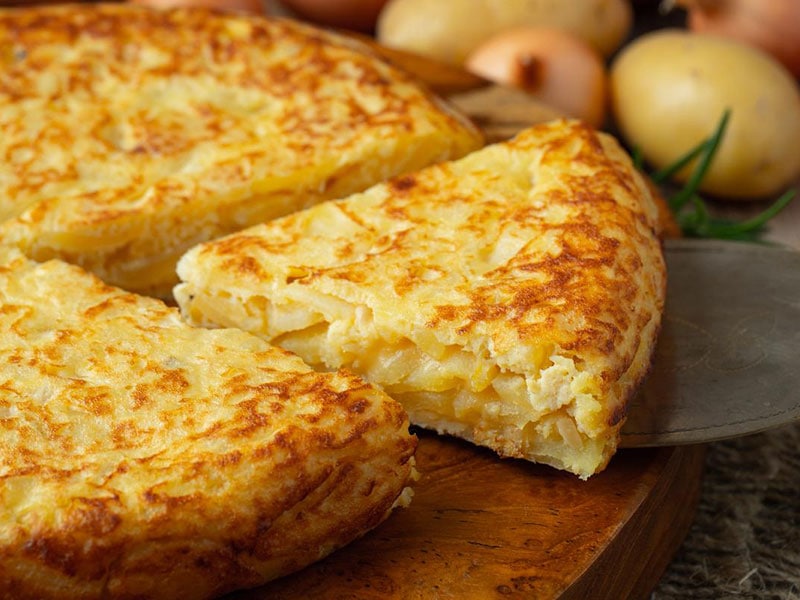
In Spain, a dish close to my heart and one that has earned national recognition is the Tortilla Espanola. Known in various parts of the Spanish-speaking world as Tortilla de Patatas or Tortilla de Oapas, this savory delight is, at its simplest, an omelet crafted from eggs and potatoes.
Sometimes, an onion might join the mix, imparting a hint of sweetness and depth. Now, there’s something uniquely comforting about the earthy flavor of the potatoes intermingling with the creamy richness of the eggs.
It reminds me of the frittata, but the Tortilla Espanola has its own unique charm. In Spain, this dish is a favorite Spanish street food option for locals. It’s not unusual to see it served at room temperature as a tapa, though I’ve also relished it hot, straight from the skillet, or even cold.
67. Gazpacho (Cold Tomato Soup)
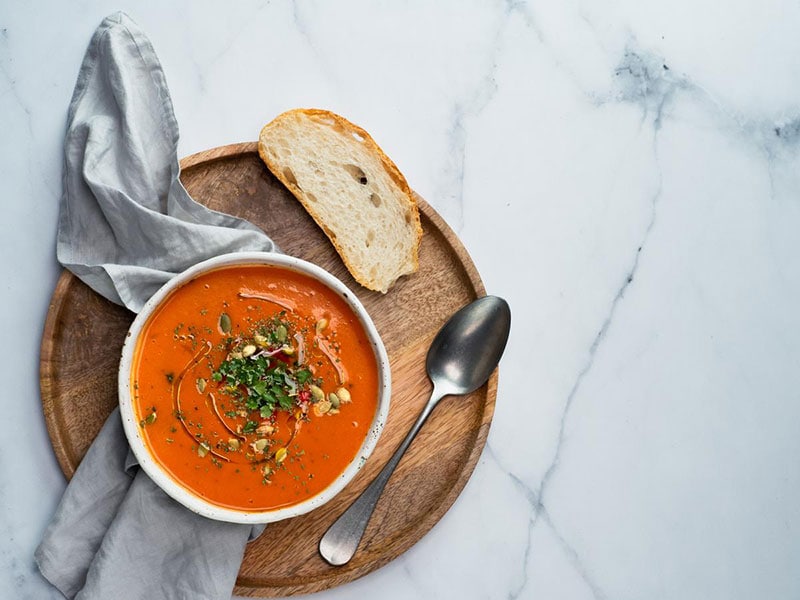
Gazpacho, a classic cold Spanish soup, holds its roots in the region of Andalucía, situated in southern Spain. Primarily a summer classic, its cold serving temperature, and refreshing qualities make it a preferred choice during those warm months.
This refreshing dish is not just an integral part of Spanish cuisine, but it has also found its way into the culinary landscape of neighboring Portugal, where it goes by the name of Gaspacho.
The soup’s profile predominantly features tomatoes. However, the choice of vegetables and herbs can vary widely among chefs, influenced by their personal preferences and the produce available in a given season.
68. Spanish Ham
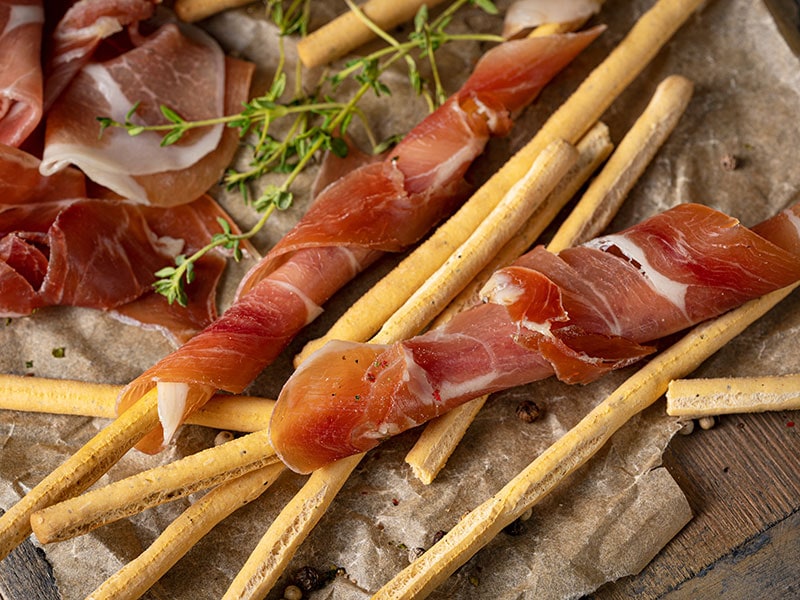
Spanish Ham, either as Jamón Serrano or Jamón Ibérico, is a standout in the realm of cured pork. On one side, you’ve got Jamón Ibérico, crafted from Black Iberian pigs, or at least a 50% mix with Duroc pigs.
Whenever I bite into a slice, my palate instantly experiences a smooth texture, rich taste, and the marbling that runs through the meat, evidence of its higher fat content. This is especially true for the ‘de bellota’ variety, which is sadly produced and exported in limited quantities.
On the other hand, there’s Jamón Serrano, which is the catch-all term for all dry-cured ham in Spain but mainly refers to products from white or non-Ibérico pigs. This is the ham that feels like home to many in Spain, being the most consumed variant.
The majority of it comes from landrace white pigs or Duroc breeds. Usually, Jamón Serrano hams take a two-week salt bath, followed by a thorough wash and a drying period lasting from 6 to 18 months.
69. Chorizo Sausage
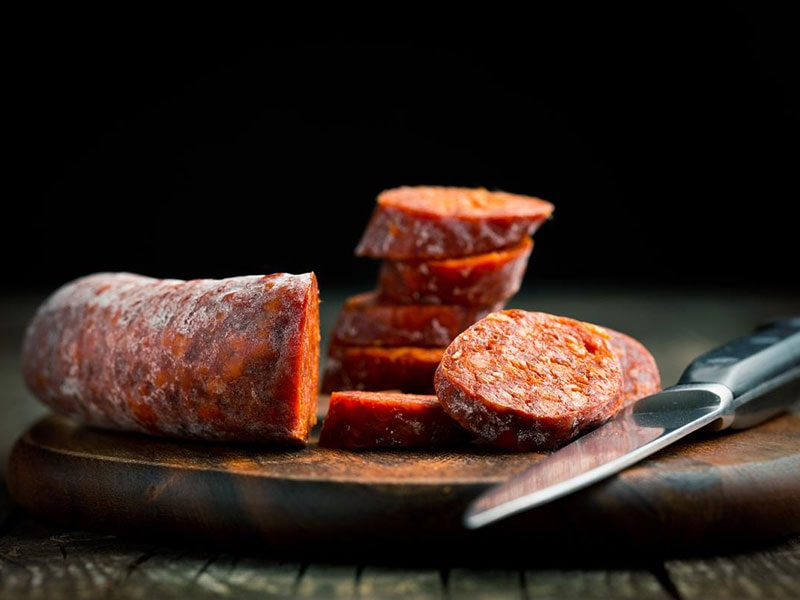
Chorizo Sausage, a pork-cured meat from the Iberian Peninsula, is the epitome of flavor. With its deep red color and composition of coarsely chopped pork and pork fat, it stands out in the vast world of sausages.
It’s not just a delicious standalone treat but also a fantastic ingredient that amplifies the flavors of any dish. Savored in sandwiches or when grilled or fried, its rich taste is undeniable.
The sausage even absorbs the depth of flavors when simmered in potent liquids like apple cider or aguardiente. It’s this versatility – from replacing ground beef or pork to coming in a range of textures like soft or hard. Furthermore, chorizo comes in various sizes, either short or long.
70. Pan Con Tomate (Tomato Bread)

Pan Con Tomate, also known as pan tumaca or pa amb tomaquet, is a beloved Catalan tapa that beautifully exhibits simplicity and flavor. A harmony of fresh tomatoes, rustic bread, or better yet, authentic Spanish bread is ideal to combine with garlic and olive oil.
Unlike Bruschetta, Pan Con Tomate is prepared by rubbing fresh garlic and ripe tomatoes over warmed, crusty bread, resulting in a fusion of robust flavors. A handy tip I’ve picked up: grate the tomatoes using a box grater, making the process so much easier.
Serving it soon after preparation is key – you don’t want the bread to turn soggy.
71. Patatas Bravas (Deep-Fried Spicy Potatoes)
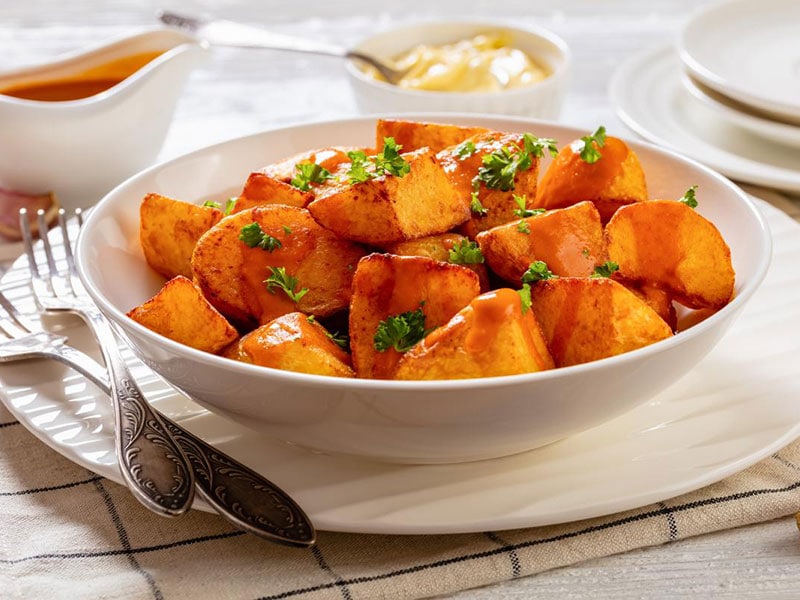
also called patatas a la brava or papas bravas
meaning “spicy potatoes”
typically consists of white potatoes that have been cut into 0.79 inches wide cubes, then fried in oil and served warm with a spicy sauce
commonly served in restaurants and bars throughout Spain as a variety of tapa
popular as a late-night snack
sometimes, the same sauce is served over mussels
traditionally served with aioli sauce on top, but other toppings can be chorizo slices or fried fish
Patatas Bravas, also known as patatas a la brava or papas bravas, translates to “spicy potatoes,” which perfectly sums up this beloved Spanish tapa. They combine a crisp exterior with a fluffy interior, topped with a flavorful burst of sauce.
The preparation involves cutting white potatoes into 0.79-inch-wide cubes, frying them in oil, and serving them warm with a spicy sauce. This is a sight you’ll see in restaurants and bars throughout Spain. They make for a fantastic late-night snack.
There’s a variation where this tangy sauce is even served over mussels. Traditionally, these crispy potatoes are topped with creamy aioli, but don’t be surprised if you come across variants with chorizo slices or fried fish as toppings.
Turkish
72. Pide (Turkish Flatbread)

Pide, a Turkish flatbread similar to pita, is baked to fluffy perfection, perfect to serve as a breakfast item. This Turkish-based food is versatile, with a round shape, perfect for wrapping kebabs or pairing with cheese, soups, and stews.
You can even create a pizza-like dish by topping it with meat, cheese, vegetables, and a runny egg. Pide has a glossy crust thanks to a generous butter brushing.
Found at Pideci stalls, it holds cultural significance. My experience at a local Pideci was vibrant, with the aroma of freshly baked bread and people savoring their Pide.
73. Lahmacun (Turkish Pizza)
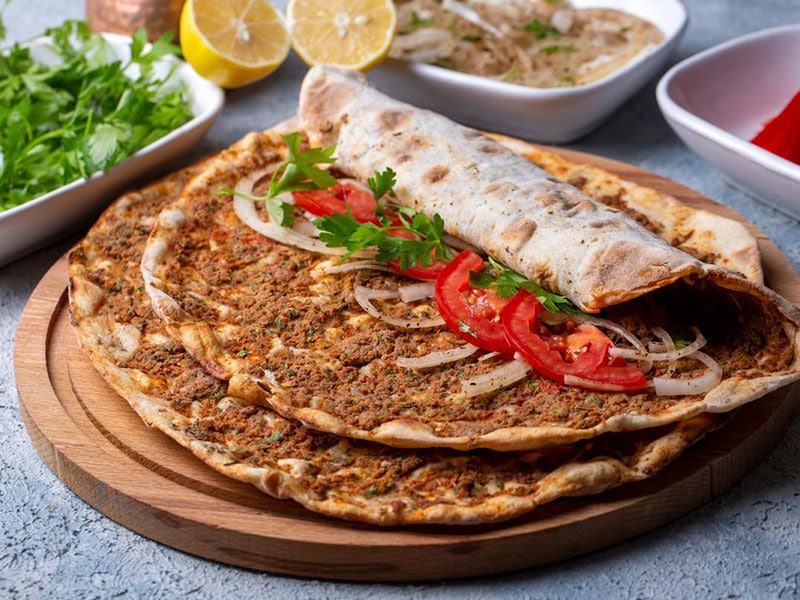
Lahmacun, also known as Turkish pizza, is quite similar to Persian Pide. The Turkish creation is a round, thin flatbread topped with flavorful ground beef or lamb, minced vegetables like onions, tomatoes, and red peppers, together with a blend of aromatic spices and herbs.
All these ingredients come together in a hot oven, creating a juicy and fragrant masterpiece. What makes Lahmacun truly unique is its combination of various flavors.
While Italian pizzas are known for their tomato sauce and cheese, Lahmacun takes a different approach. It boasts a thinner base, and instead of cheese, it draws its richness from savory meat and vibrant spices.
Lahmacun is a popular street food and a go-to snack that you can find in many corners of Turkey. You can savor it on its own or pair it with pickles, roasted eggplants, fried onions, or a refreshing Piyaz salad made with parsley and beans.
74. Mantı (Savory Dumpling)
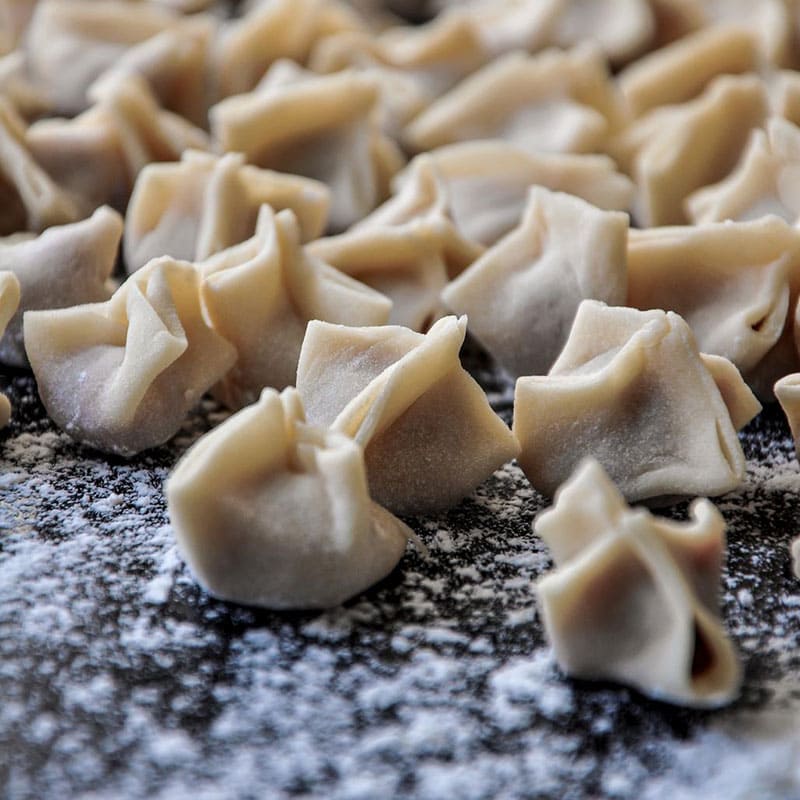
Turkish Mantı, a savory dumpling, stands apart from its Central Asian and Caucasian counterparts. These smaller-sized dumplings are baked or boiled, not steamed, and filled with flavorful ground lamb or beef seasoned with parsley, paprika, black pepper, and finely chopped onions.
Compared to Asian and European dumplings, these Mantı are smaller and usually baked or boiled instead of steamed.
What sets Turkish Mantı apart is its requirement for three specific toppings. These include a yogurt and garlic sauce, a spicy butter sauce with chili pepper flakes, and a caramelized tomato sauce.
75. Dondurma (Turkish Ice Cream)

Dondurma, also known as Maraş ice cream, hails from the city of Maraş, now called Kahramanmaraş near the Syrian-Turkish border. This is a beloved snack, dessert, and street food that you can find in specialized Dondurma shops across Turkey.
Dondurma has a unique stretchy and chewy consistency, so much so that it is often enjoyed with a knife and fork. Unlike Western ice cream, Dondurma doesn’t melt easily, thanks to the addition of mastic resin and salep, a flour made from the starchy roots of wild orchids.
The sweet flavors of Dondurma are complemented by the exotic aromas of mastic resin and salep. From classic flavors like vanilla and chocolate to more adventurous ones, there’s a wide range to choose from.
76. Lokum (Turkish Delight)

Lokum, also known as Turkish Delight, has a rich history that dates back to the 18th century in Constantinople, now Istanbul, the capital city of Turkey. It’s a prominent Turkish sweet treat that can be found in various colors all across the country.
This sweet confection is prepared with water, cornstarch, and sugar along with chopped nuts like walnuts, hazelnuts, or dates. It’s also flavored with ingredients such as lemons, bergamot orange, or rosewater.
You might come across Lokum garnished with crushed nuts, icing sugar, or powdered cream of tartar. One of the distinctive features of Lokum is the gel-like texture that makes it a joy to chew on.
Overall, it’s a wholesome dessert with a soothing effect. Interestingly, the name Lokum comes from an Arabic word that means “throat comfort.”
Balkan
77. Cevapi / Ćevapi (Mici) (Skinless sausages)
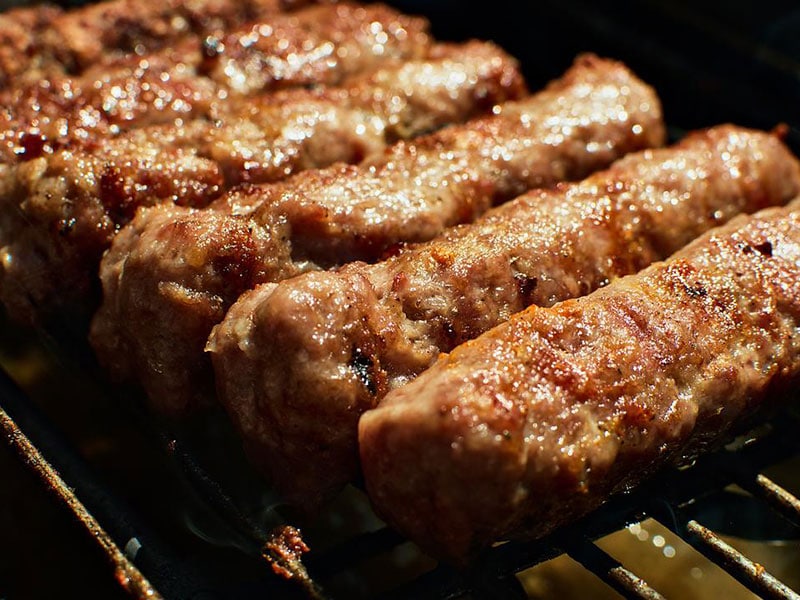
Cevapi, also known as Ćevapi or Mici, is a delicious grilled dish of minced meat that hails from the southeastern countries of Europe. These skinless sausages are typically served in groups of five to ten pieces on a plate or nestled inside a flatbread like lepina or somun.
To enhance the flavors, they are often accompanied by a medley of toppings such as chopped onions, sour cream, kajmak (milk cream), ajvar (relish), and a sprinkle of salt.
Serbian ćevapčići, a specific variation of cevapi, can be made using beef, lamb, pork, or a mixture of these meats. In fact, by 1932, ćevapčići had gained such popularity that they were considered a local specialty in southern Serbia.
78. Banitsa (Cheese Pastry)
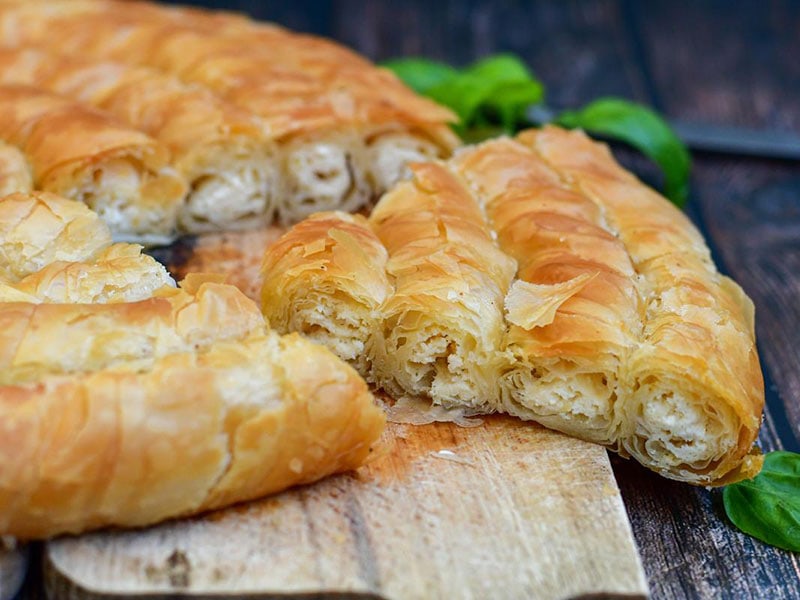
Banitsa is a beloved cheese pastry from Bulgaria. This popular delicacy is made by layering phyllo pastry with a mixture of yogurt, brined cheese, and whisked eggs, resulting in a delectable combination of sweet, tangy, and salty flavors.
While the classic version features this cheese filling, Banitsa can also include additional ingredients like vegetables (spinach, cabbage, pumpkins), lentils, mushrooms, or even ham and minced meat.
This tasty treat holds a special place during Christmas and New Year’s Eve celebrations, where it is enjoyed as a staple treat. It is not uncommon to find small charms like coins or written wishes called “kusmeti” hidden within the layers.
Banitsa can be savored as a breakfast dish and pairs perfectly with yogurt, tea, or coffee.
79. Mekitsa (Fried Dough)
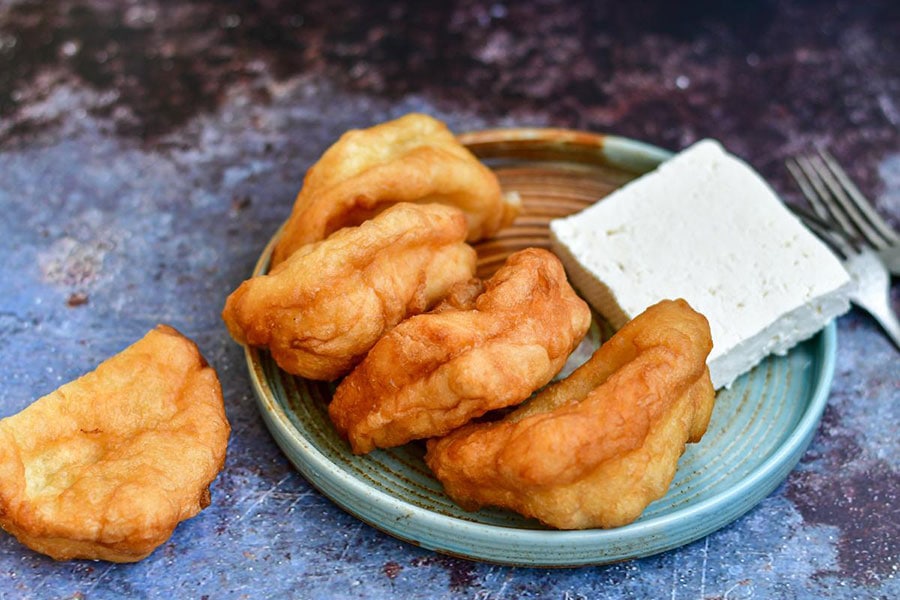
Mekitsa, a Bulgarian specialty also popular in Serbia and North Macedonia, is a delicious fried dough treat. Made with a simple mixture of flour, eggs, yogurt, salt, oil, and yeast or baking powder, these doughy delights are deep-fried until they turn a beautiful golden hue.
Mekitsa is often enjoyed by pairing it with cheese, yogurt, or fruit jams. Traditionally served for breakfast, it offers a rich and savory taste with a soft and inviting texture.
In North Macedonia, Mekitsa holds a special significance and is a traditional dish served at parties celebrating the arrival of a newborn baby. This versatile treat can be enjoyed on various occasions and is sure to bring joy to any gathering.
80. Pršut (Dry-cured Ham)
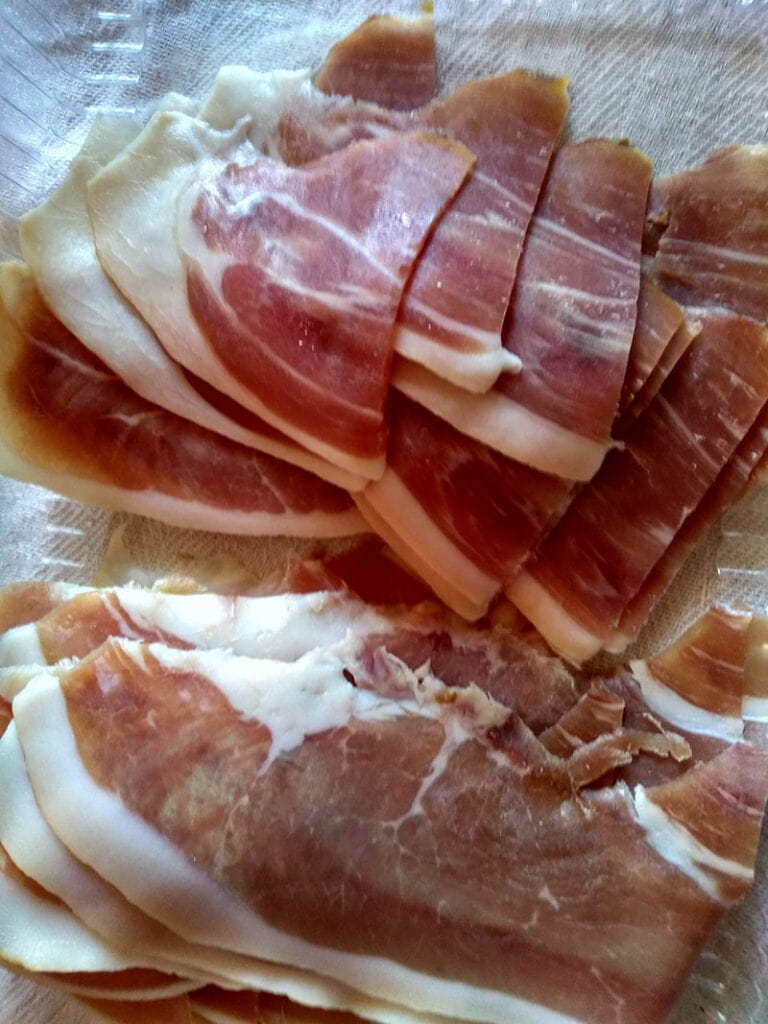
Pršut, hailing from the Balkans, is a delicacy among dry-cured hams, with Croatian varieties standing out in quality. Made from fresh pork legs, it’s smoked or air-dried to perfection. When paired with cheese, bread, and an assortment of fruits, Pršut’s distinct flavors truly sing.
Among the renowned Pršut varieties, Dalmatinski Pršut from Dalmatia, Croatia takes the spotlight, gaining its unique character from being smoked. On the other hand, Drniški Pršut, a product of Istria and Slovenia, relies on the wind to dry for a full 12 months.
Njeguški Pršut, which originates from Njeguši in Montenegro, adds a delicate twist by being lightly smoked and dried in the cool mountain breeze for months.
81. Cicvara (Corn Flour And Cheese Porridge)
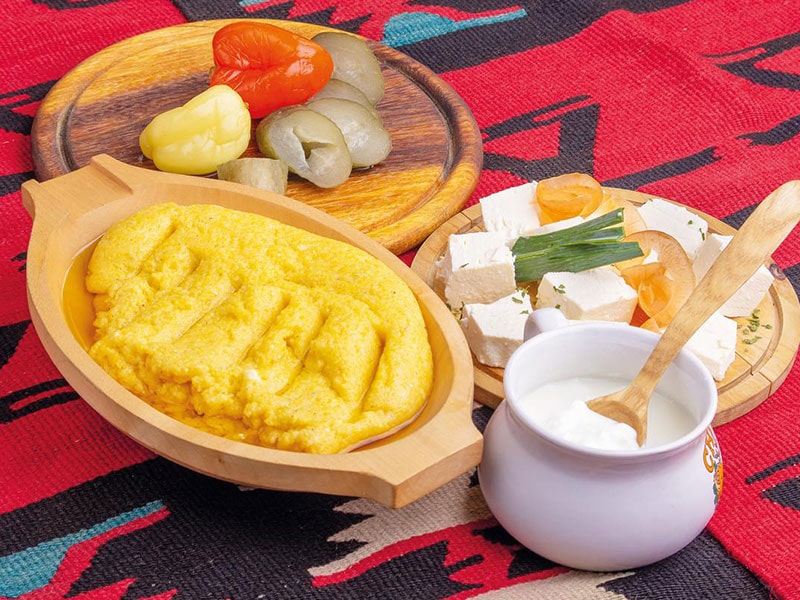
Cicvara, a warming corn flour and cheese porridge from Montenegro and Herzegovina, stands as a festive beacon in the cold winters.
Corn flour, milk, salt, and cheese, notably Škripavac, a local cheese made from raw cow milk or cottage cheese, are used in the preparation of Cicvara. The inclusion of mature Kajmak, a type of clotted cream, lends the dish its beautiful golden hue and rich flavor.
Highly calorific and full of fats, it’s a firm favorite as a traditional Christmas breakfast. For the finishing touch, add more cheese, sour cream, bacon, or smoked ham to bring an extra layer of indulgence.
82. Tavče Gravče (Macedonian Baked Beans)
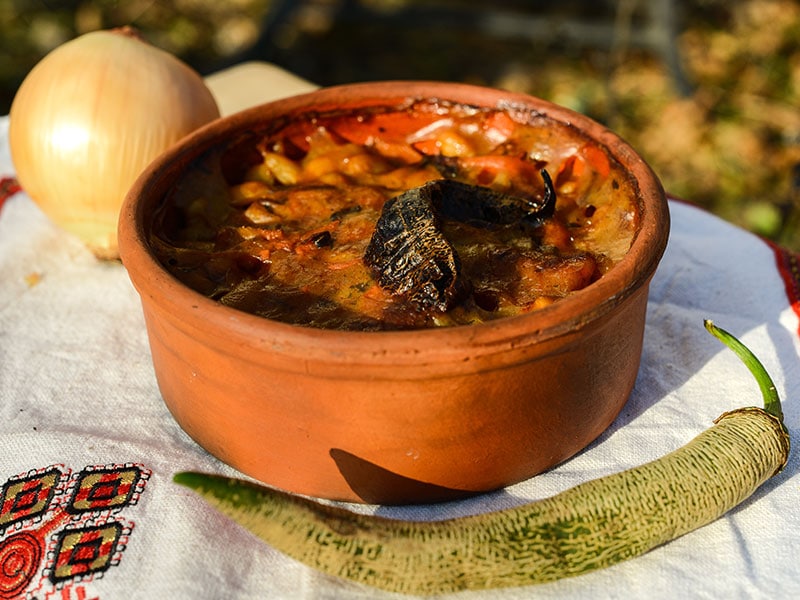
Tavče Gravče is the national favorite dish of Macedonia, especially in the Northern region. At its heart are Tetovac, large, flat white beans from the Serbian city of Tetovo, though you can swap them with white butter beans.
Its name meaning ‘beans on a tava’ – a metal cooking utensil of Persian origin – is a bit of a misdirection, as this savory masterpiece is prepared and served in an unglazed earthenware pot.
You can enrich it by adding vegetables like onions and bell peppers. While the dish can include lamb or beef, this version keeps things plant-based.
83. Gibanica (Cheese-filled Pastry)
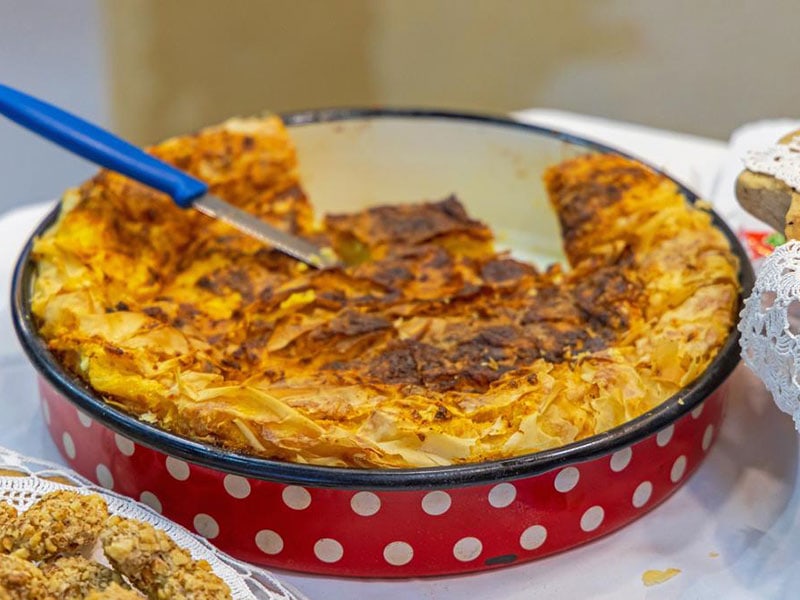
Emerging in the early 19th century, Gibanica is a cherished cheese-filled pastry. Resembling Burek in some aspects, it takes a simpler approach with its ingredients.
Gibanica’s charm lies in its phyllo dough layers, generously filled with cheese, especially feta and cottage cheese. Add sour cream and eggs to the mix, and you’ve got a dish that’s delightfully rich, swinging from sweet to salty in taste.
This versatile pastry comes in various forms, from a single cake to a multi-layered marvel, and is a favorite across the Balkans. Whether as a breakfast item, an appetizer, or a snack, Gibanica always hits the spot.
For a winning combination, pair it with yogurt or Ajvar, a roasted red pepper sauce, to accentuate its flavors.
84. Pljeskavica (Serbian Burger)
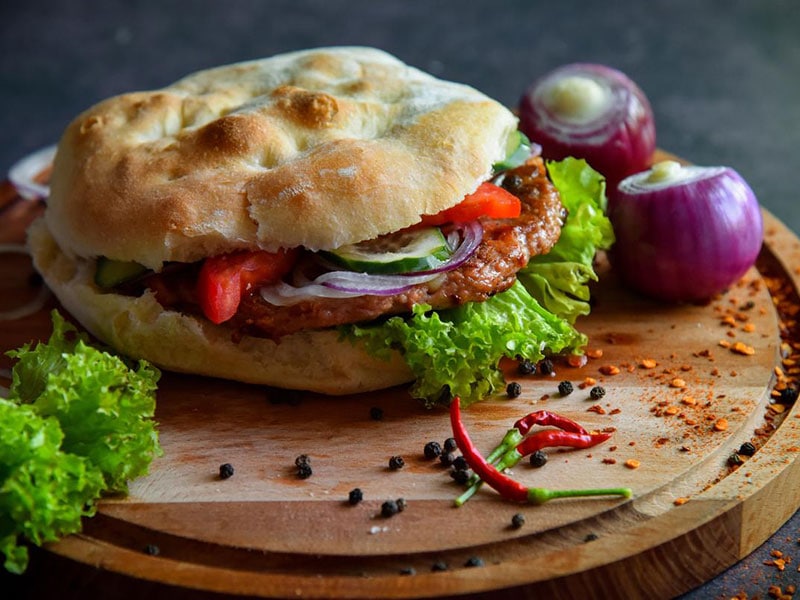
Pljeskavica, a Serbian grilled dish, is a vibrant medley of pork, beef, and lamb in the form of a spiced meat patty. Hand-picked seasonings, including paprika, salt, and pepper, along with finely minced onions and garlic, are the secret behind the aromatic taste.
Holding its place as a Serbian national dish, Pljeskavica takes the spotlight as a main course, partnered with onions, kajmak (milk cream), ajvar (relish), and urnebes (spicy cheese salad).
You can savor it on a plate with side dishes or tuck into a Lepinja, a thick flatbread. The first time I tried Pljeskavica was in a specialty fast food restaurant in Germany when its smoky brown color and moist, juicy texture taught me what love was at first bite.
The right ratio of meat to fat in the preparation process is crucial and can be tricky to master. There are two significant varieties – gourmand’s Pljeskavica and stuffed Pljeskavica.
The former, spiced with hot pepper flakes, tiny cheese cubes, and pieces of bacon; the latter, filled with sliced cheese, bacon, and occasionally, ham.
85. Ajvar (Roasted Bell Pepper Condiment)
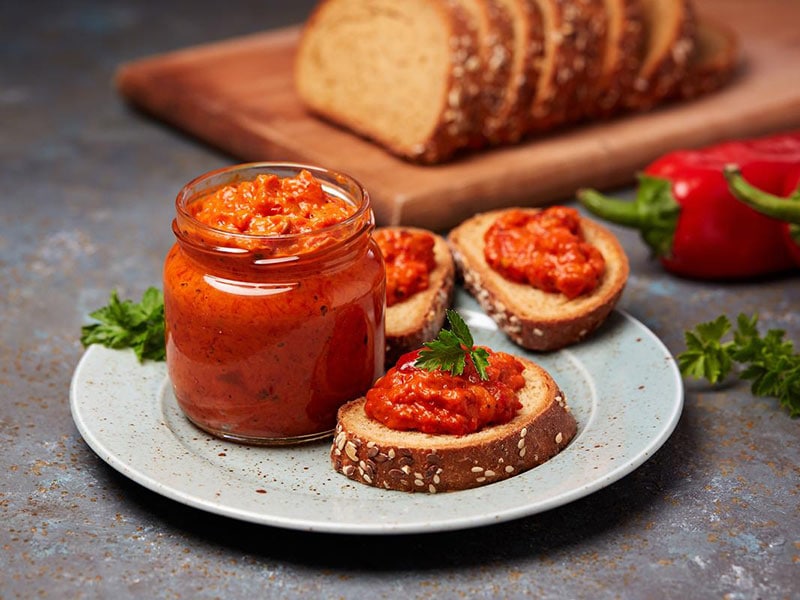
Ajvar, pronounced as I-var, is a delightful roasted bell pepper condiment that will add a burst of flavor to your dishes. It is made by cooking roasted bell peppers with sunflower oil, and for those who enjoy a spicy kick, chili peppers can be added to the mix.
This versatile condiment can range from sweet to mildly spicy or even very spicy, boasting a charmingly rich, smoky flavor and aroma. To enhance the complexity of Ajvar, some variations include tomatoes and eggplants, adding a touch of bitterness or tanginess.
It can be used as a spread, relish, sauce, or even a side dish. Whether you pair it with cheese, toast, pasta, crackers, or even the delicious Ćevapi, Ajvar is sure to elevate your culinary experience.
Not only does Ajvar offer a silky texture and a beautiful red color, but it is also highly popular in the countries that formed the former Yugoslavia. In fact, the BBC even nicknamed it the “caviar” of the Balkans, highlighting its esteemed status and widespread appreciation [6].
86. Karađorđeva Šnicla (Serbian Breaded Cutlet Dish)
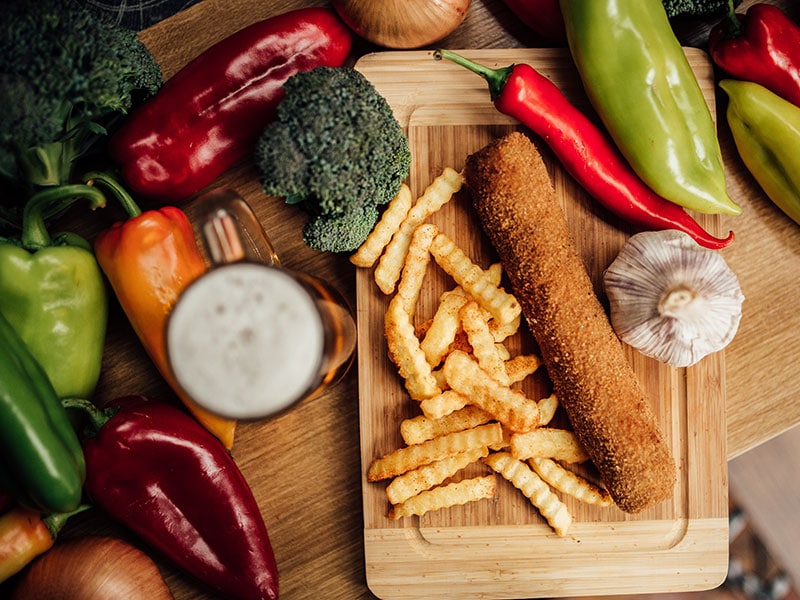
Karađorđeva Šnicla, named after Serbian revolutionary Karađorđe, is a breaded cutlet dish that tells a delicious story. Born in the 1950s, it owes its existence to a chef aiming to prepare Chicken Kiev but ended up creating a masterpiece with veal when the chicken ran out.
It’s a roll of veal or pork steak enveloping Kajmak, a kind of clotted cream, which is then breaded and fried to golden perfection. This dish is enhanced when paired with tartar sauce, roasted potatoes, and a refreshing lemon wedge.
And there’s a playful side to this dish, too. With its phallic shape, it carries a second name, ‘devojački san’ or ‘maiden’s dream’.
87. Rakia (Fruit Spirits)

Rakia, also known as Rakija or Raki, is a distinctive fruit spirit adored in the Balkans, and also well-received in Turkey, Greece, and parts of Eastern Europe.
It’s a marvel of fermentation and distillation processes, transforming fruits like grapes, plums, cherries, apricots, pears, and peaches into a high-octane beverage. Commercial drinks hover around 40% ABV, but home-brewed varieties can rocket up to an eye-watering 80% ABV!
That’s why it’s wise to savor Rakia in slow, small sips from tiny glasses. No wonder it’s served as a warm welcome to guests and even a morning reviver for some locals.
Another charm of Rakia is its versatility. It can don a cloak of colorlessness when herb-free or boast a flavorful profile with the addition of herbs like woodworm, sage, mint, rosemary, or lavender.
88. Prebranac (Serbian Bean Stew)
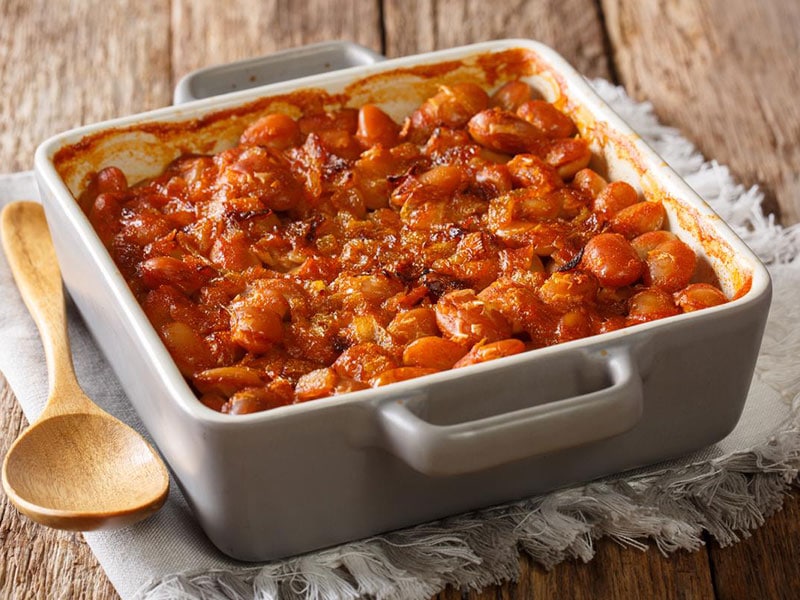
Prebranac, a wholesome Serbian staple, originated as a hearty winter dish among peasants, valued for its nutritious blend of affordability and simplicity.
This stew begins with simple white beans, which are turned into a creamy, flavorful dish. This transformation is achieved through a careful baking process that includes caramelized onions, olive oil, spices, garlic, and a generous amount of paprika.
Its rich taste and meat-free recipe have made Prebranac a favorite during Orthodox fasting periods. Pair this stew with a slice of crusty bread to soak up every last bit of its enticing flavors.
89. Čvarci (Pork Cracklings)
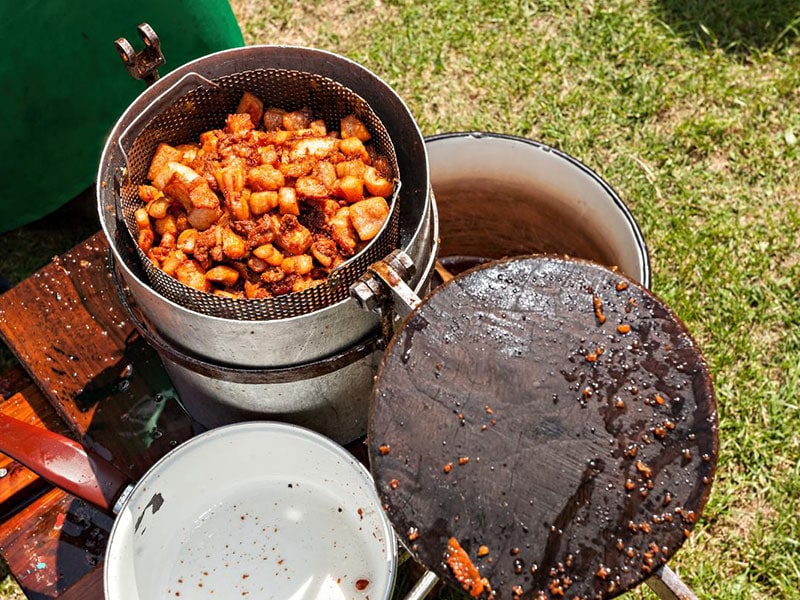
A rustic specialty from the countryside, Čvarci, or pork cracklings, have found popularity not only in the Balkans but also across Central and Eastern European countries.
These savory morsels are prepared by slicing lard into small pieces and frying them in their own fat until they reach a mouth-watering crispiness. Salt, milk, spices, onions, and garlic may be added for an extra flavor kick.
Čvarci is a versatile food that can be enjoyed as a standalone snack or served as an appetizer with bread and rolls. It can also be used as a key ingredient in other snacks, such as Čvarkuše, which are Croatian pork crackling biscuits.
90. Vanilice (Serbian Vanilla Cookie)

Vanilice, the endearing “little vanillas,” hold a special place in Serbian Christmas traditions. Embracing the Orthodox faith and the Julian calendar, Serbians celebrate Christmas on January 7th, a celebration that is incomplete without these cookies.
The flavorful combination of ingredients such as all-purpose flour, ground walnuts, vanilla extract, lard or butter, and egg yolks creates the base of these cookies. They are then filled with apricot or rose hip jam, and generously coated with vanilla sugar for a stunning snow-white appearance.
Moreover, Vanilice has a one-of-a-kind aging process; they shouldn’t be eaten immediately. Instead, these cookies are left alone for 1 to 2 days, allowing them to achieve their signature buttery, melt-in-your-mouth texture.
91. Ghiveci (Balkan Vegetable Stew)
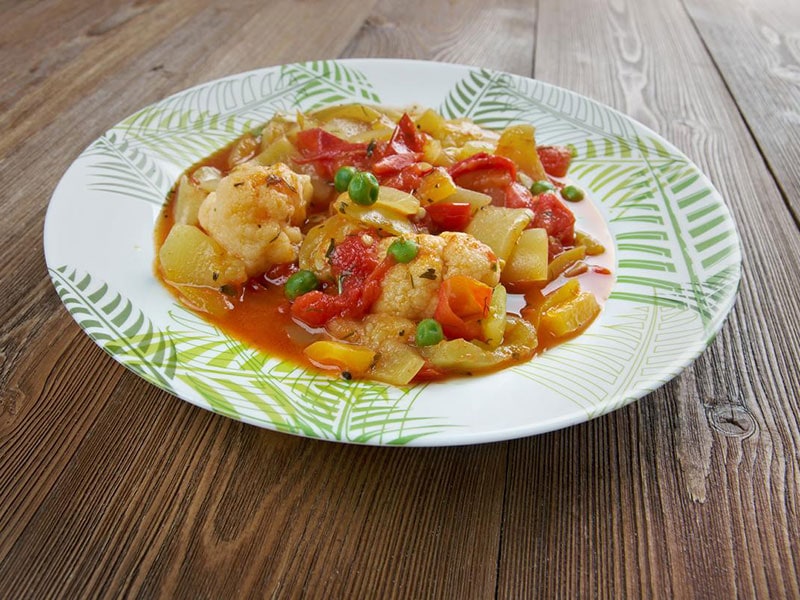
Ghiveci, also known as Ghivetch, is a beloved Balkan vegetable stew with deep roots in Eastern Europe, particularly in Bulgaria and Romania. This hearty dish, believed to be of Turkish origin, is traditionally cooked in a Güveç, an earthenware pot extensively used in former Ottoman territories.
Ghiveci celebrates the bounty of seasonal vegetables, with common choices including tomatoes, carrots, eggplants, bell peppers, celery, cabbage, zucchini, and potatoes. Its richness may remind you of French ratatouille, but Ghiveci is notably easier to prepare.
While the dish is inherently vegan, the addition of beef or mutton can bring in more flavors and nutrients, appealing to diverse palates.
Regardless of variations, Ghiveci’s comforting, home-cooked charm resonates across borders and cuisines, making it a well-received dish across the Balkans and Eastern Europe.
Others
92. Burek (Phyllo Pastry With Fillings) – Turkey, Greece, And The Balkans
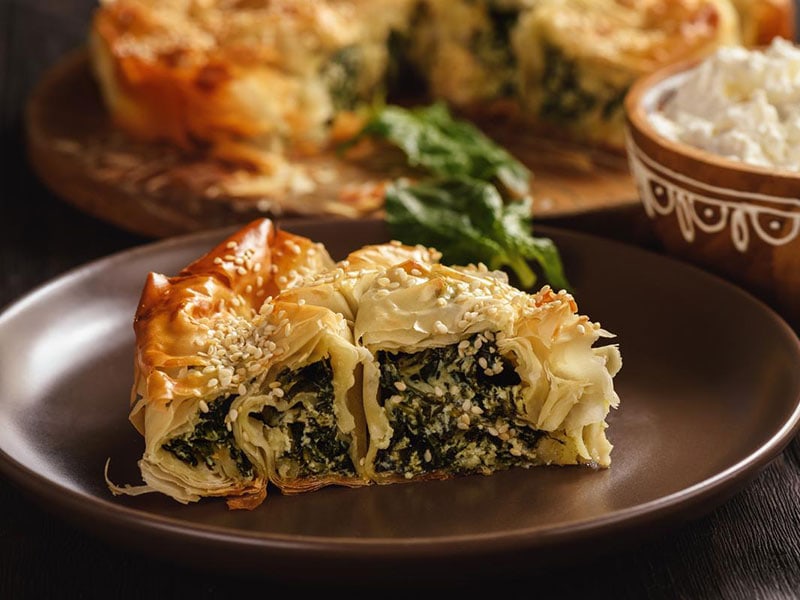
Burek, also known as Byrek, Börek, Boureki, Byurek, or Borek, has an intriguing history rooted in Turkish or Persian culinary traditions.
This pastry marries a flaky dough with an array of savory fillings. These fillings can include meats, such as beef or lamb, feta cheese, legumes, mushrooms, or an assortment of vegetables, including potatoes, eggplants, and spinach.
Its distinctive snail-like shape is a sight to behold, and when it’s baked or deep-fried, the golden and crispy crust becomes irresistible.
There are many variations of Burek. One example is the Turkish Chebureki, which resembles an empanada. Another is the Greek Spanakopita, a savory spinach pie. The popular Bosnian Burek also deserves mention, being a common street food throughout the Balkans.
Best consumed as a breakfast or snack, Burek pairs beautifully with yogurt, but if you’re in the mood for something lighter, a refreshing salad will do just as well.
93. Kebab / Kebap – Turkey, Greece, And The Balkans
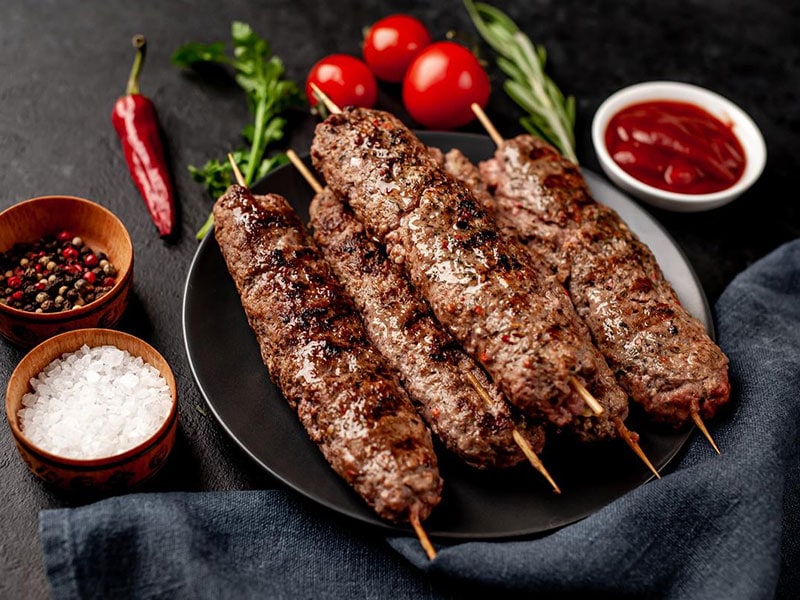
Kebabs, also referred to as Kebap, are a critical element of Turkish cuisine. They have also permeated various other cultures. Particularly, cultures that were part of the Ottoman Empire, such as Greece and the Balkans, have embraced this dish.
Kebap originally began as a form of street food. The dish comprises tender cubes of marinated meat, which can include lamb, chicken, beef, or pork. These pieces of meat are threaded onto skewers.
Often, the meat is combined with vibrant vegetables such as tomatoes, zucchini, and bell peppers on the same skewers. Finally, the assembled skewers are grilled until they reach the desired level of doneness.
The side dishes accompanying kebabs range from rice and pasta to fresh salads, grilled fruits, roasted potatoes, and corn on the cob.
Other variants of Kebab include the Adana Kebab, with its long, hand-minced meat strips, and Shish Kofta, essentially meatball kebabs. My personal favorite is the Doner Kebab, where the meat is cooked on a vertical rotisserie and shaved into warm pita bread.
While distinct in preparation and flavor profiles, the Greek Gyros is a close cousin, aligning most with the Doner Kebab.
94. Köfte (Meatballs) – Turkey, Greece, And The Balkans
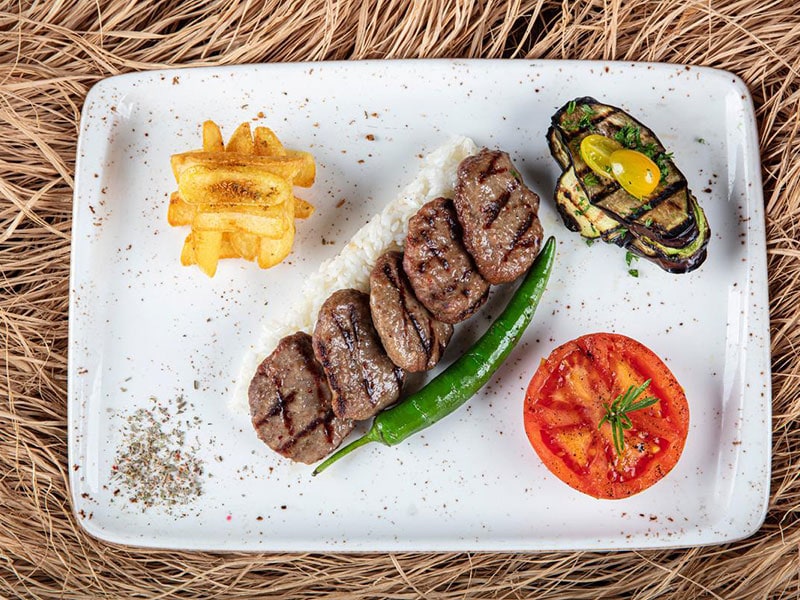
Turkish cuisine features an array of notable dishes, one of which is the Köfte, alternatively known as Kofta in some regions. These are small meatballs prepared from ground lamb or beef. The meat is seasoned with a selection of aromatic spices for added flavor.
Köfte can be cooked using a variety of methods. These include frying, grilling, steaming, and baking. In certain situations, they are even consumed raw. You can also serve the dish cold.
When there’s a variety of mezze to enjoy, you often find these small tasty bites that you can easily pick up with a toothpick. These meatball accompaniments are usually pita bread, dips, and salads that stand out on the table. You can also cook them in the broth if you prefer.
Notable varieties include the grilled İnegöl Köfte from Bursa, the Shish Köfte akin to skewered kebabs, the steamed Islama Köfte, and Sulu Köfte, a flavorful meatball stew with vegetables.
Then there’s the Çiğ Köfte, a delicacy from Urfa, consisting of raw beef or lamb, bulgur wheat, spices, tomatoes, and onions.
95. Dolmas / Dolmades (Stuffed Vegetables) – Turkey, Greece, And The Balkans
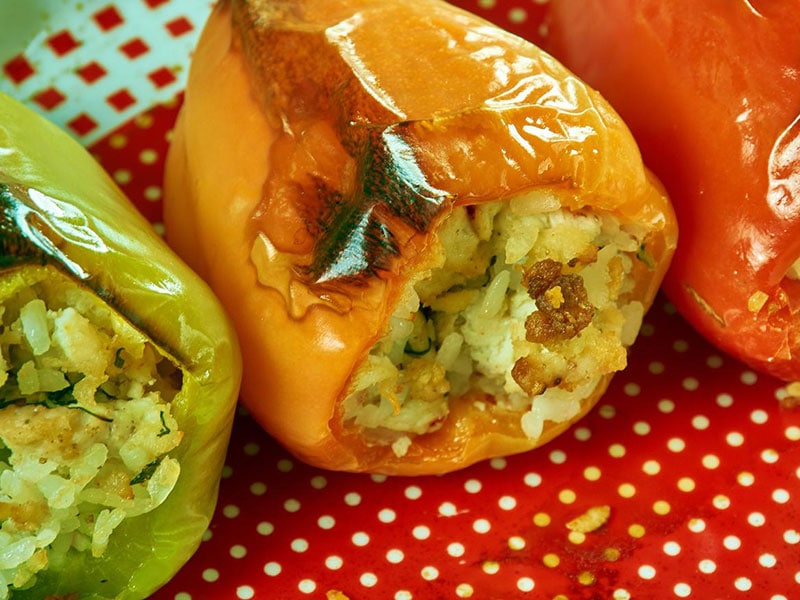
Dolmas, or Dolmades, is a cornerstone of Ottoman cuisine. The word “Dolmas” translates to “stuffed” in Turkish, which precisely describes the dish.
It involves hollowing out vegetables like zucchini, eggplants, or bell peppers, and filling them with a blend of seasoned rice, spices, herbs, and a selection of ground meat or seafood. Beef and mutton are traditional choices, but inventive twists can include chicken, quails, squids, octopus, or even animal offals.
This dish is typically served as part of a mezze spread, and you can enjoy it either hot, stewed gently in its juices, or cold, adorned with a generous drizzle of olive oil. Cold Dolmas often swap meat for an aromatic mix of rice or bulgur wheat, dried nuts, and spices.
It’s worth noting that there’s a slight variation named Sarma, involving leafy greens wrapped around a filling. However, many still refer to it as Dolmas, which might stir up a little confusion.
96. Sarma (Stuffed Grapevine Leaves) – Turkey, Greece, And The Balkans
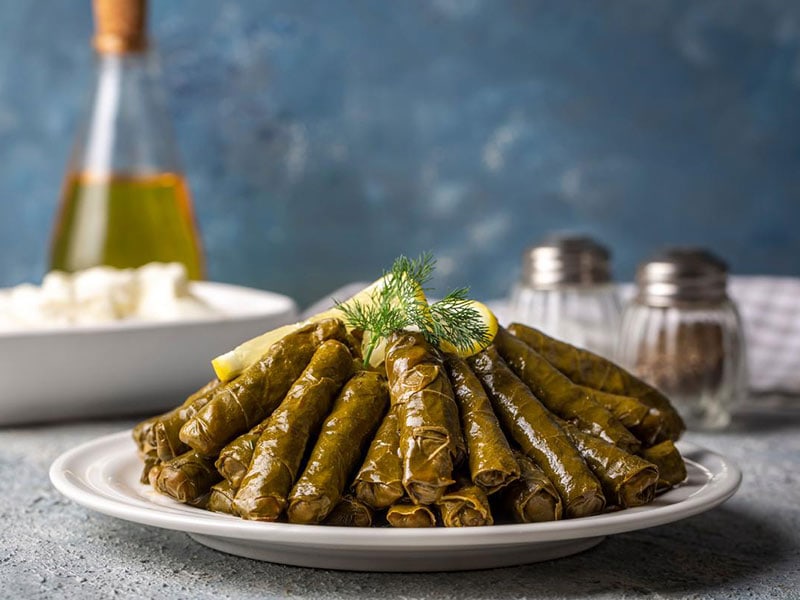
Sarma, which translates to “wrapped” in Turkish, involves the artful rolling of vegetable leaves around a savory filling.
This process closely mirrors that of Dolmas, but instead of stuffing hearty vegetables, Sarma shines the spotlight on cabbage, grapevine leaves, collards, or kale. Among them, grapevine leaves are an especially popular choice.
Although Sarma and Dolmas often get mixed up, here’s an easy way to remember: all Sarmas are Dolmas due to the shared concept of stuffing or wrapping, but not all Dolmas are Sarmas.
97. Kajmak (Clotted Cream) – Turkey, Greece, And The Balkans
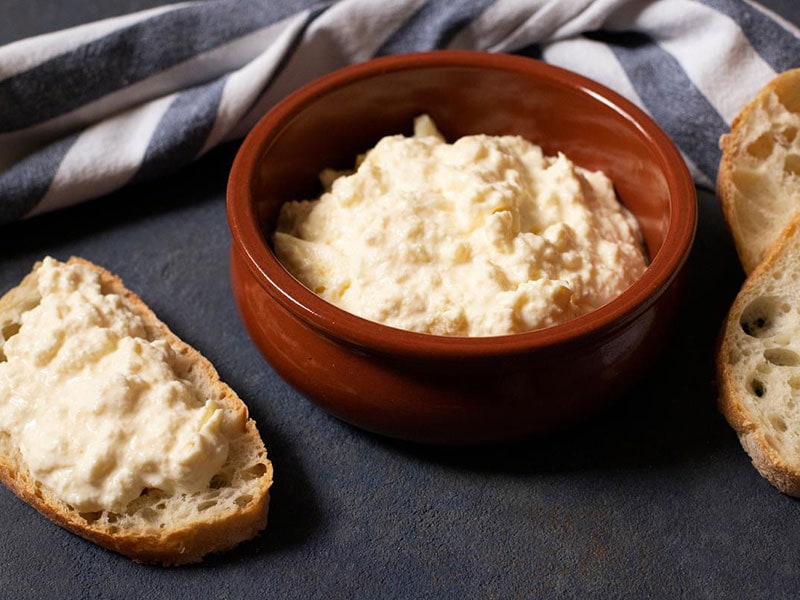
Kajmak, alternatively called Kaïmaki, is a dairy product originating from Turkish culinary practices. It has been embraced by various regions, including the Balkans, Greece, and several Middle Eastern countries.
In terms of texture, Kajmak is rich and fluffy. It bears a resemblance to clotted cream or cream cheese. Flavor-wise, it features a distinctive sweet and sour edge, which is akin to the taste of fresh cheese.
Due to its high-fat content, it has many applications. For instance, Kajmak can replace butter as a spread on bread, act as a sumptuous condiment for burgers, or even serve as a luxurious filling for snacks and desserts.
People usually prefer fresh Kajmak, but it doesn’t last long. That’s one of the reasons why it’s hard to find outside the places where it’s made. Some people also add a bit of salt and let Kajmak age for a few months to give it a stronger taste.
98. Baklava (Phyllo Pastry Dessert) – Turkey, Greece, And The Balkans

Baklava is a special dessert that started in the Ottoman Empire. Now, it’s popular in many places, but especially in Turkey, Greece, and the Balkans.
To make Baklava, the locals first layer thin pieces of phyllo dough with crushed nuts, like walnuts or pistachios. Then, the pastry is finished with a generous pour of syrup or honey on top.
To add another dimension to its already rich, sweet, and flaky persona, it can be crowned with ice cream or clotted cream.
One might be surprised at the cost of Baklava in Western countries, but when you consider the premium ingredients and the intricate craftsmanship required, it’s entirely justified.
Even though Baklava has lots of sugar, it’s still packed with nutrients and people all over the world love it. It’s often the main dessert at big celebrations like Eid al-Fitr, Rosh Hashanah, Easter, and Christmas.
Here’s a cool fact: sometimes at Christian celebrations, Baklava might be made with exactly 33 or 40 layers. This represents how many years Jesus lived and the number of days in Lent.
99. Spoon Sweets
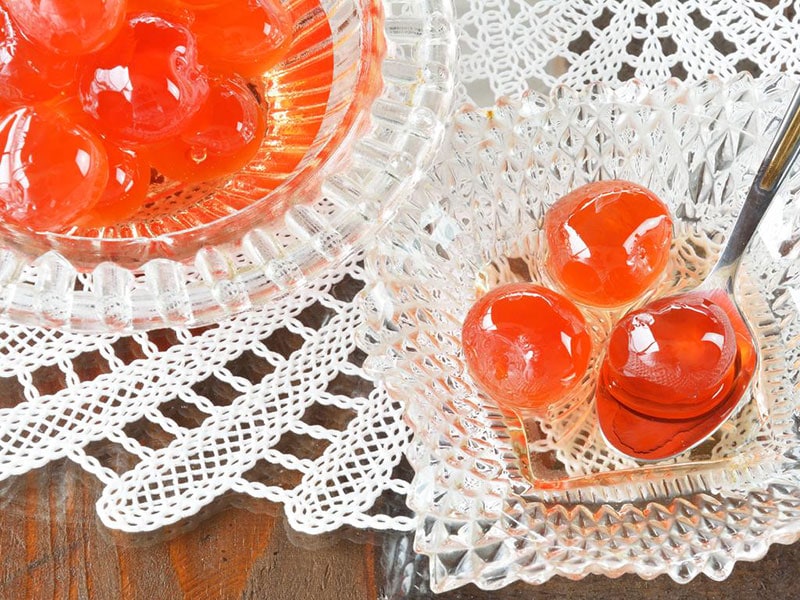
Spoon Sweets, as their name suggests, are sweet preserves presented in a spoon alongside a small dish or bowl. As a staple in Greece and scattered across the Balkans, they are a hallmark of hospitality, often presented to guests.
Spoon Sweets have the versatility to be made from a multitude of fruits, with the tart ones typically favored. Think along the lines of strawberries, grapes, apples, prunes, apricots, quinces, oranges, pomegranates, and figs.
What’s important is that these preserves maintain the original fruit’s taste and aroma. When it comes to serving, these versatile preserves add a sweet touch to a cheese board, complement a cup of coffee, or even provide a refreshing bite when served with cold water.
In addition, they also lend a fruity burst when added as a topping to pancakes, yogurt, or ice cream.
100. Peka (Baked Meat And Vegetables) – Croatia
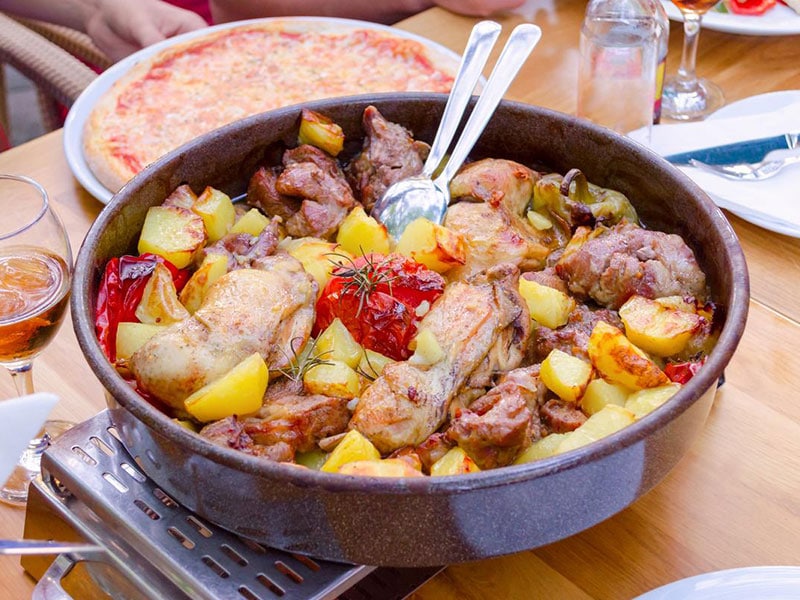
Peka, hailing from the Dalmatian region, is both a cherished Croatian dish and the name of the unique cooking vessel used to prepare it. This dish is slow-cooked to perfection and often stars meat – think veal or lamb, chicken, and even seafood like octopus.
The chosen star ingredient melds beautifully with olive oil, herbs, and vegetables such as carrots and onions, with potatoes playing an integral role. The signature pot, made of clay or wrought iron, has a bell-like shape, which is quite fitting, as ‘peka’ translates to ‘bell’.
The real beauty of Peka lies in the method of cooking. The bell pot, filled with delicious ingredients, gets nestled among hot coals on all sides, even on top, ensuring thorough cooking from every direction.
This process, which can take hours, incorporates elements of roasting, baking, and steaming, rendering an end product that’s soft, juicy, and aromatic.
Southern European Culinary Influences On Global Cuisine
Italy
Italian cuisine holds a special place in the hearts of food enthusiasts worldwide. Italian dishes like pasta, pizza, and risotto have become staples in many countries. The use of fresh, high-quality ingredients is at the core of Italian cooking.
Olive oil, tomatoes, garlic, basil, and Parmesan cheese are just a few of the iconic ingredients that have found their way into kitchens around the world. The simplicity and versatility of Italian cuisine have made it universally loved.
Spain
Moving on to Spain, this country has given a treasure trove of culinary goodness. Tapas, paella, and sangria are just a few examples of Spanish culinary contributions. Spanish cuisine celebrates bold flavors and regional diversity.
The use of spices like saffron, smoked paprika, and garlic adds depth to many dishes. Additionally, Spanish cuisine showcases a love for seafood, as well as cured meats like jamón ibérico.
The country’s vibrant food culture has influenced global dining trends and popularized the concept of sharing small plates.
Greece
Greece has also made a lasting impression on global cuisine. Greek cuisine emphasizes fresh, seasonal ingredients, such as olive oil, herbs, and vegetables. Classic dishes like moussaka, souvlaki, and tzatziki have gained international recognition.
Greek cuisine showcases the art of simplicity, allowing the flavors of individual ingredients to shine. Ingredients like Feta cheese, olives, and oregano have become household favorites in various parts of the world.
Portugal
Lastly, let’s not forget Portugal, a country with a rich culinary heritage. Portuguese cuisine is known for its diverse seafood dishes, hearty stews, and delectable pastries. Bacalhau (salted cod) is a staple in Portuguese cuisine, prepared in numerous mouthwatering ways.
The country’s exploration and trade history have also contributed to a fusion of flavors, with influences from Africa, Asia, and the Americas. Portuguese custard tarts (pastéis de nata) are a beloved dessert that has gained popularity globally.
FAQs
The Legacy of Southern European Cuisine Lives On
Southern European cuisine is full of culinary traditions that have stood the test of time. The vibrant flavors, hearty ingredients, and cultural significance of these recipes paint a vivid picture of a region steeped in gastronomic heritage.
From the aromatic paellas to the indulgent baklavas, each bite tells a story of generations past. Don’t forget to like, share the post. In addition, join the conversation in the comments below to help keep the flame of these traditions alive for generations to come.
References
- Chrysopoulos, P. Greek Orthodox easter: Everything you need to know, GreekReporter.com.
- Rampanti G;Ferrocino I;Harasym J;Foligni R;Cardinali F;Orkusz A;Milanović V;Franciosa I;Garofalo C;Mannozzi C;Mozzon M;Osimani A;Aquilanti L; Queijo Serra da Estrela PDO cheese: Investigation into its morpho-textural traits, Microbiota, and Volatilome, Foods (Basel, Switzerland).
- Howe, M. (no date) In Portugal, fresh sardines, The New York Times.
- Rousseau, G. Tagus.
- Albanese, C. and Salzano, G. (no date) Italy can officially say everyone loves its gelato, Bloomberg.com.
- Pisker, L. Ajvar: The Vegan ‘Caviar’ of the Balkans, BBC Travel.

